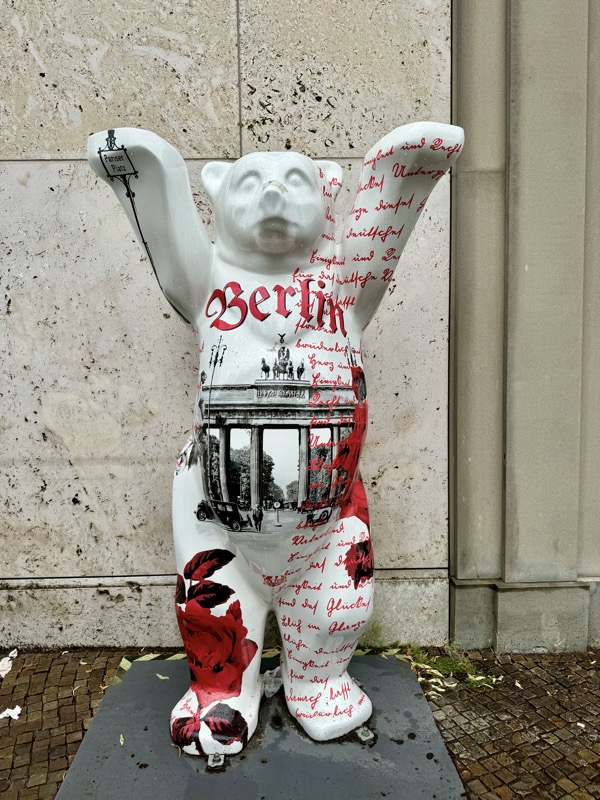Berlin Bear No 1: Hotel Bear near Alexanderplatz! We are staying in the Park Inn by Radisson for a few nights in Berlin. Some work around the Eurocup infrastructure and hopefully Angus will get to see some cool stuff while we are here.
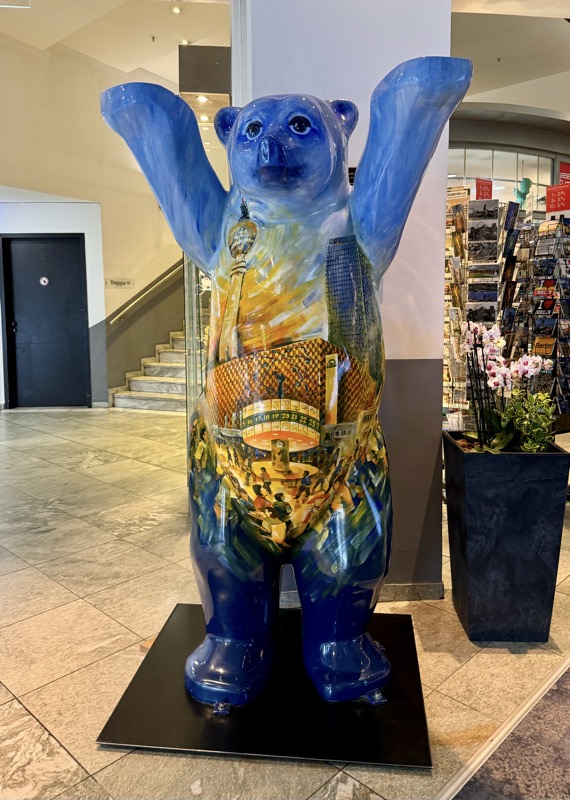
Managed to get some work done and find time to head over to Museum Island for a while. We started at the Nues Museum (which ironically holds a lot of the oldest stuff) because the Altes Museum and the Bodes Museum were closed on Monday *and* Tuesday! Le sigh… you guys are killing us!
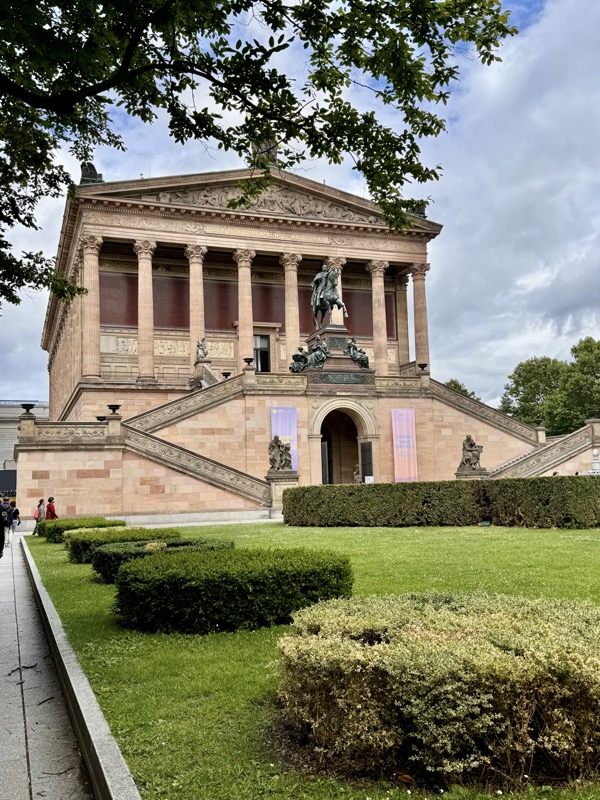
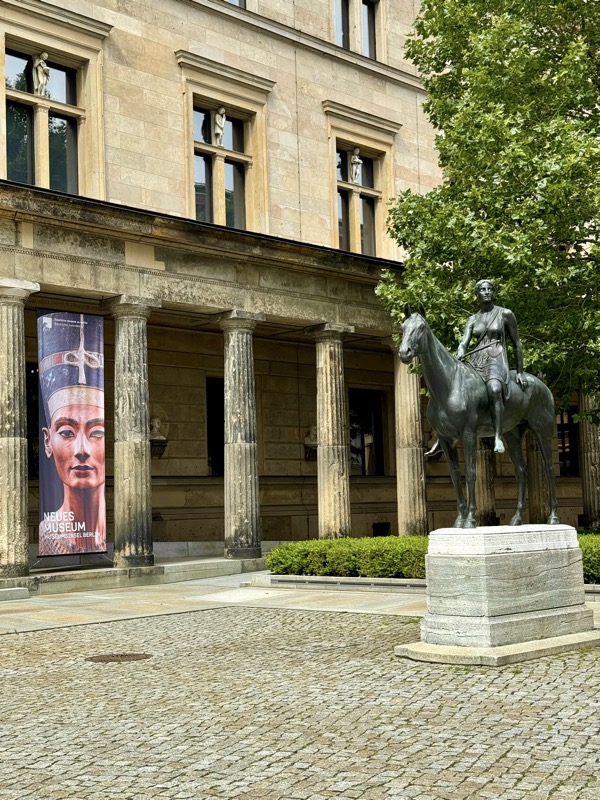
Egyptian artefacts aren’t really my usual cup of tea, but we are here to see what we can see.
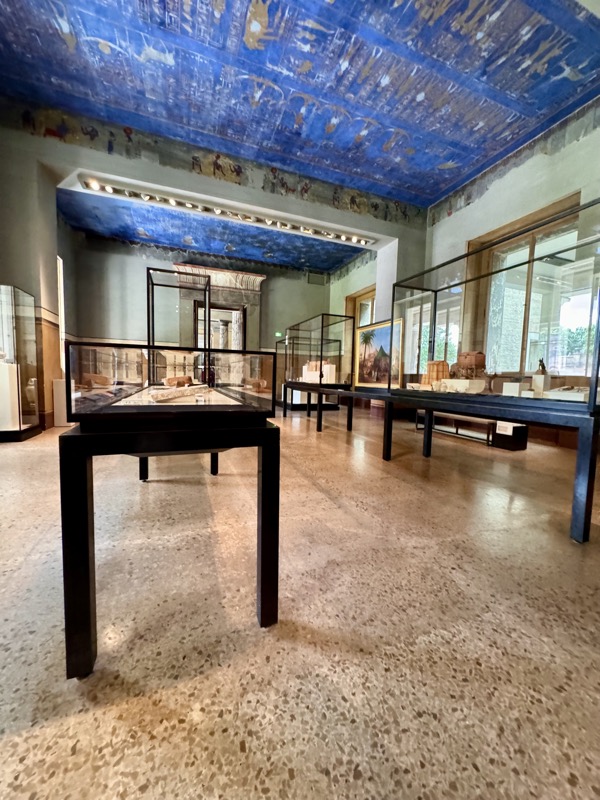
The Deceased in front of Osiris – unfortunately the plaque didn’t give me any provenance/age for this piece.
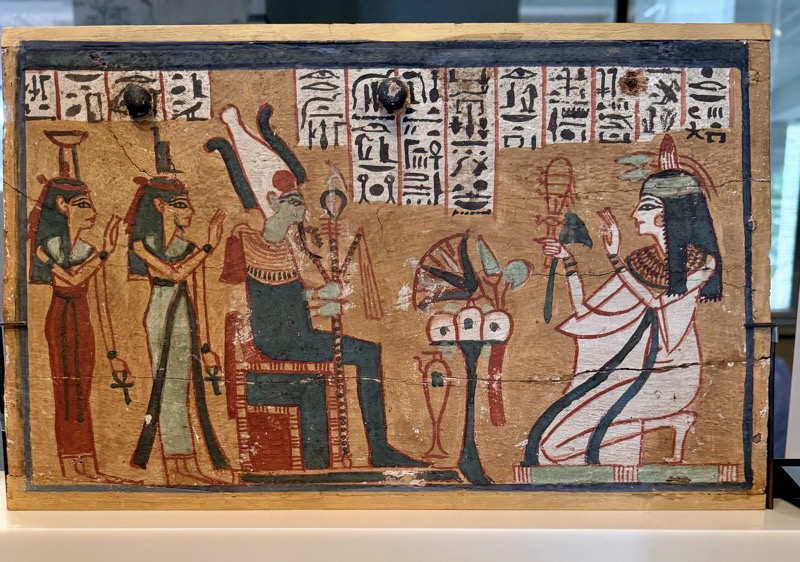
Necklace of semi-precious stones and pearls – lapis lazuli, silver, faience, cornaline.
Middle Kingdom, 12th Dynasty.
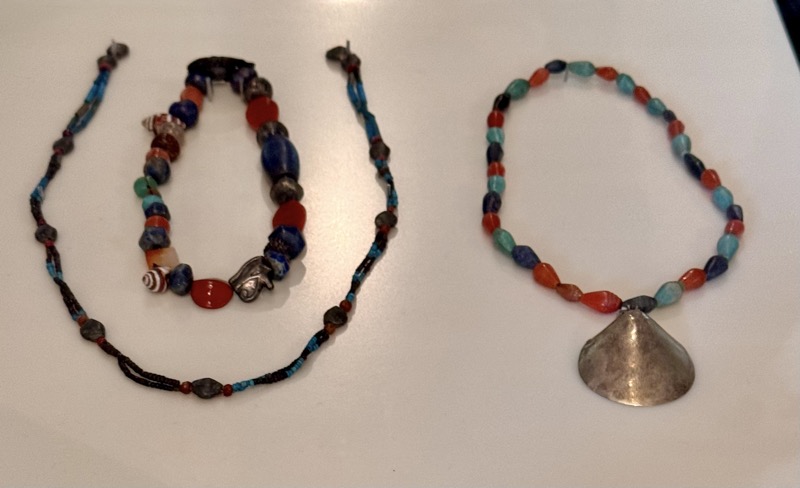
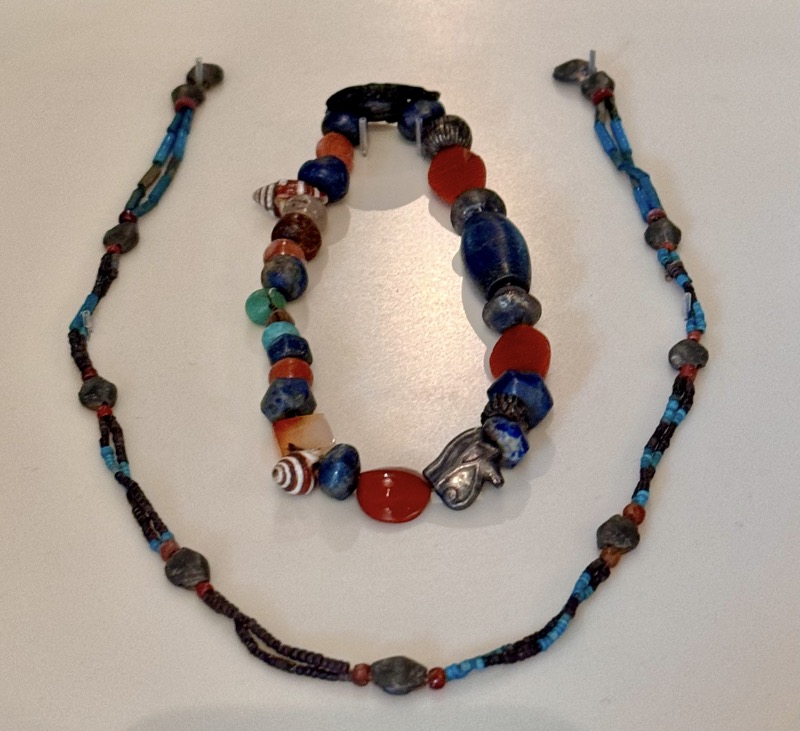
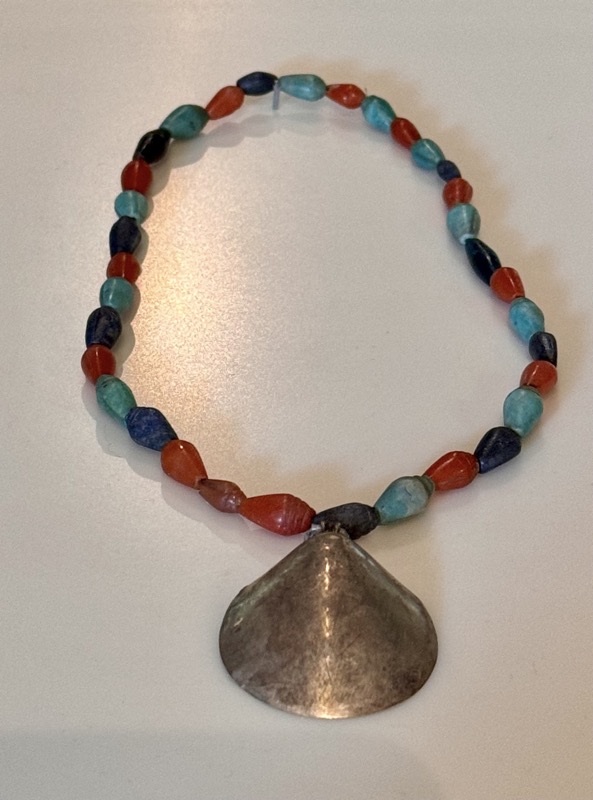
Fragment of a Cult vessel with inlays. Old Kingom, 5th Dynasty, c.2490 BC, sycamore, faience, gold leaf.
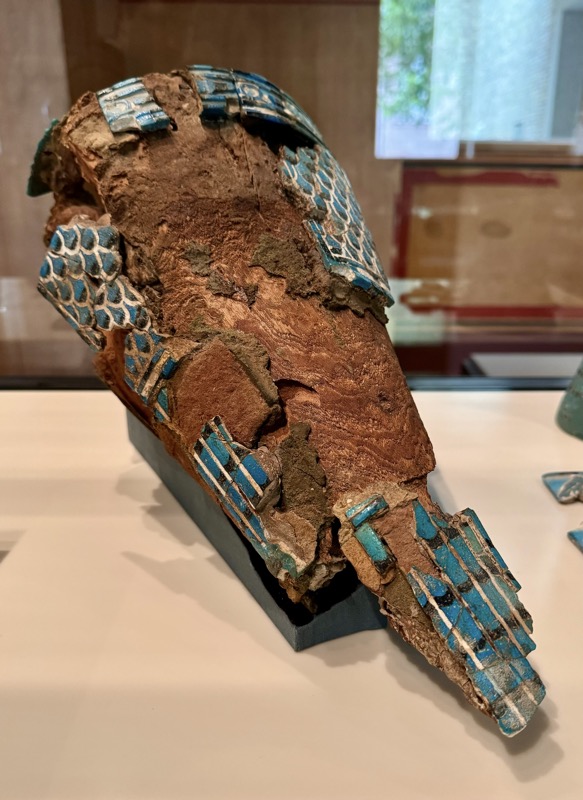
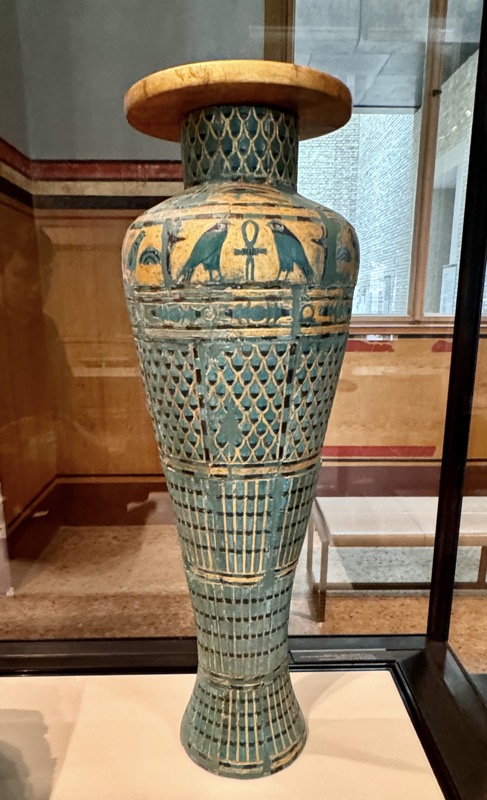
Twelve antique scarabs, set as a necklace and earrings.
Middle Kingdom, 12th Dynasty, c. 794BC, Egypt, steatite (glazed), glass.
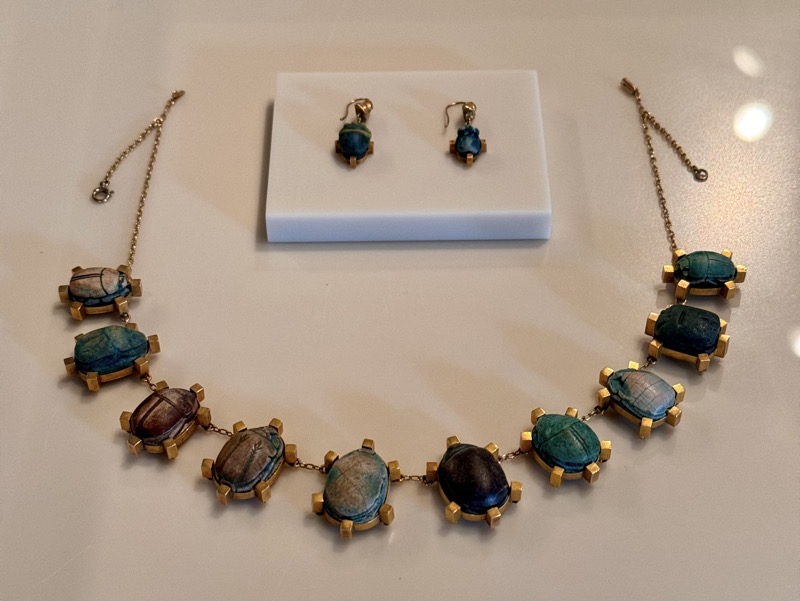
Praying statue of King Amenemhet III, Middle Kingdom, 12th Dynasty, c.1800BC

LEFT: Painting from a Tomb: Representation of the deified queen Ahmose-Nefertari.
RIGHT: Painting from a Tomb: Representation of the deified Pharaoh Amenhotep I.
New Kingdom, 20th Dynasty, 1186-1070BC. Nile mud, stucco, painted.
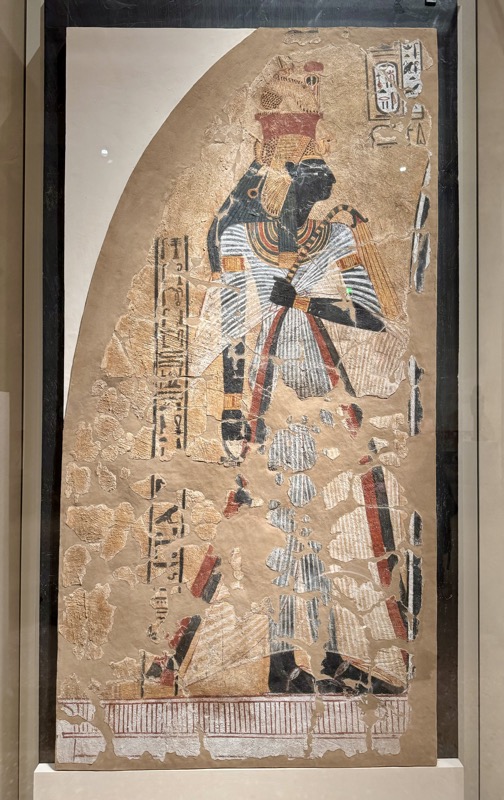
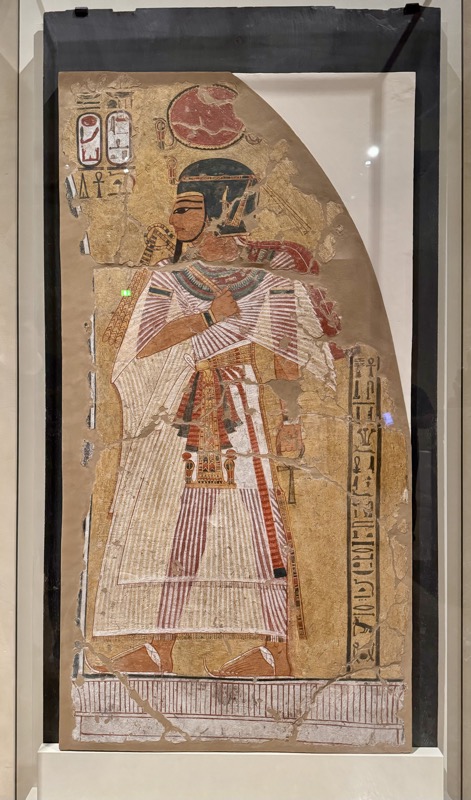
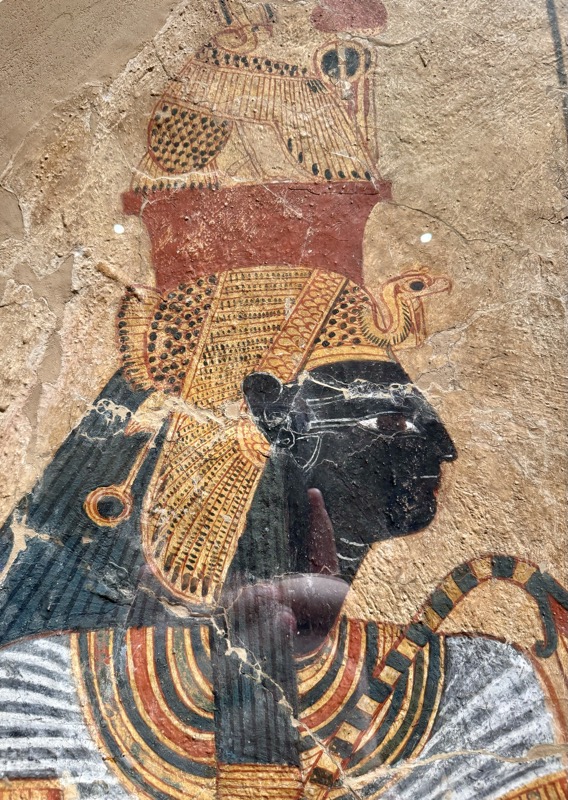
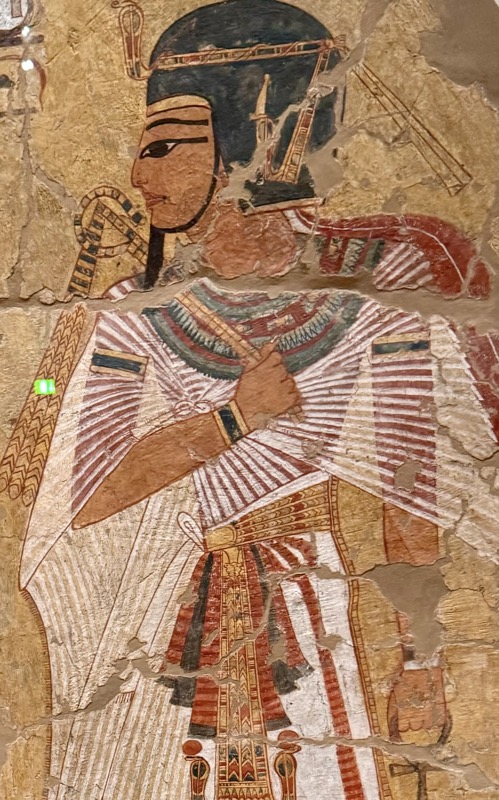
Fragment of a pillar: King Seti I in front of the god Osiris. New Kingdom, 19th Dynasty, c.1290 BC
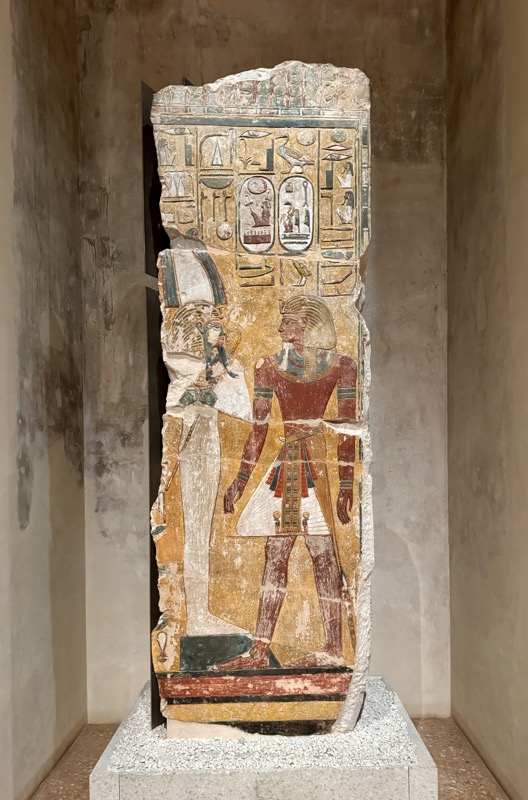
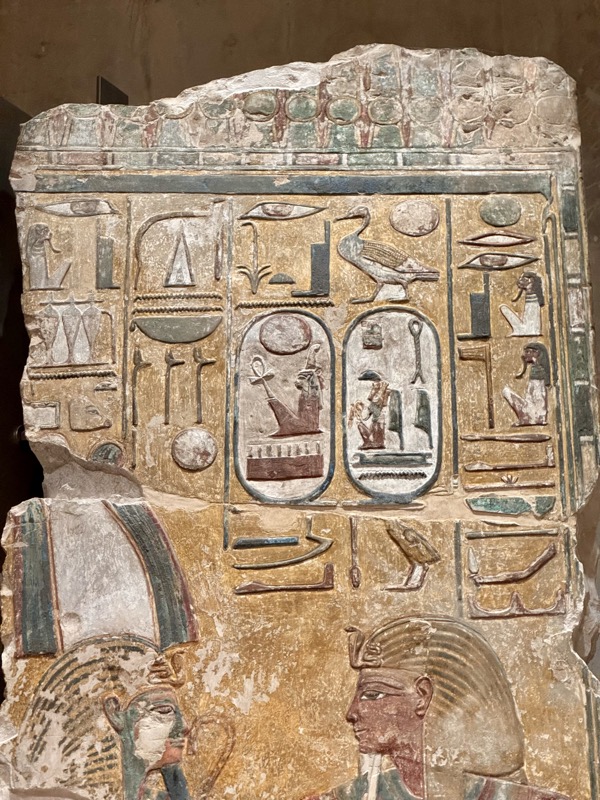
Head of a statue of Amenhotep III with nemes-scarf and double crown.
New Kingdom, 18th Dynasty, c.13399-1351 BC.
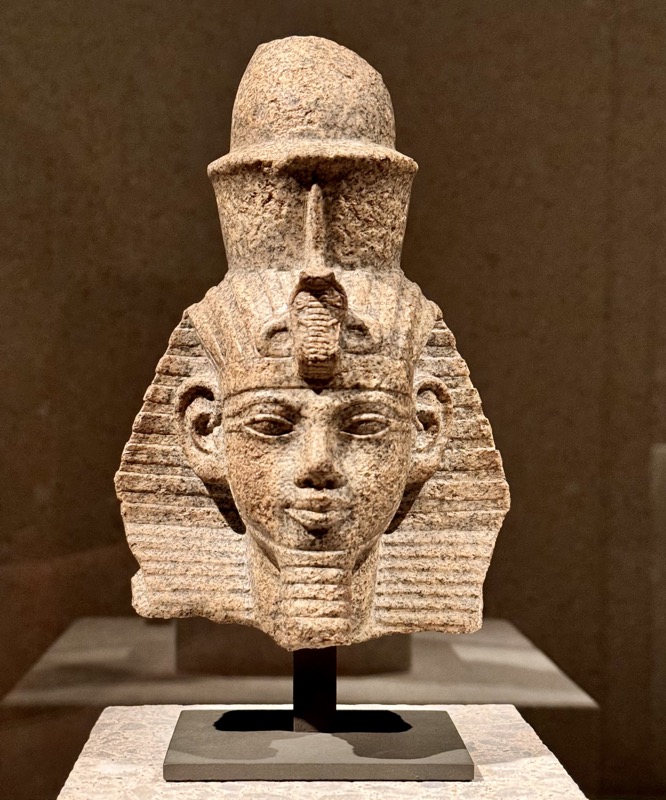
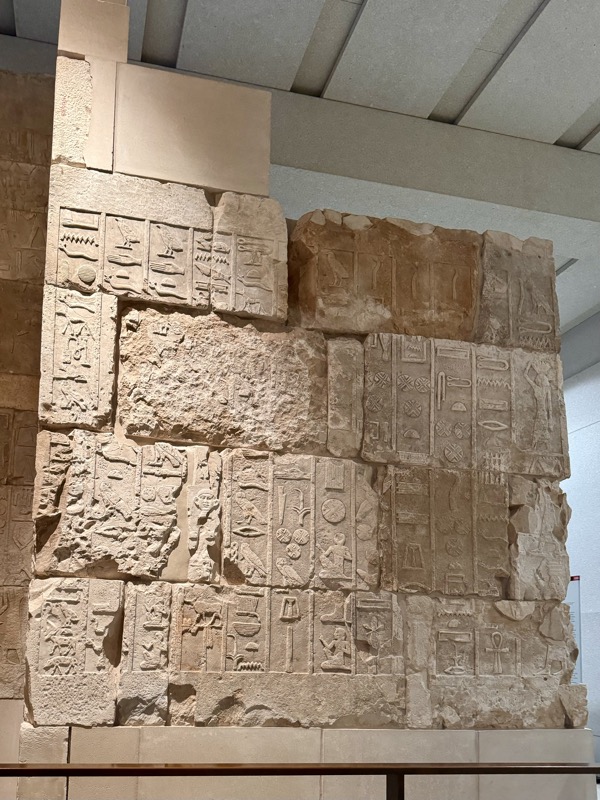
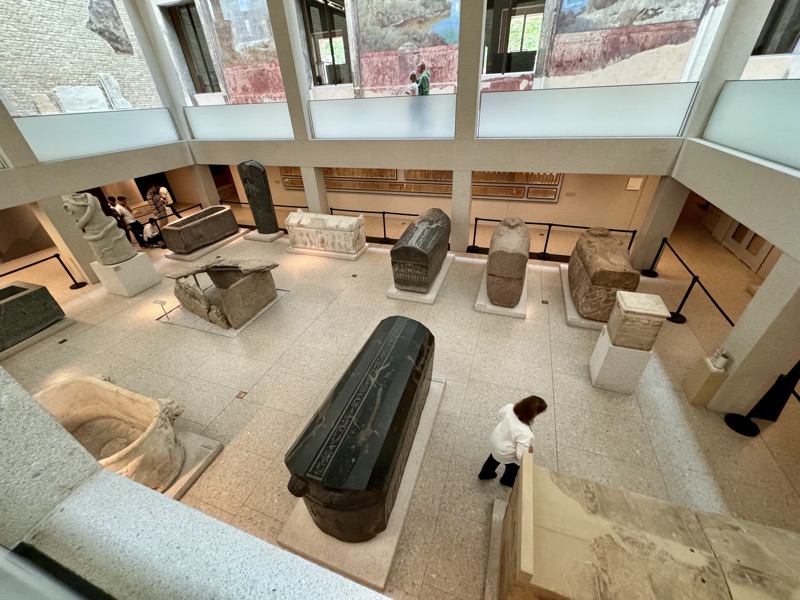
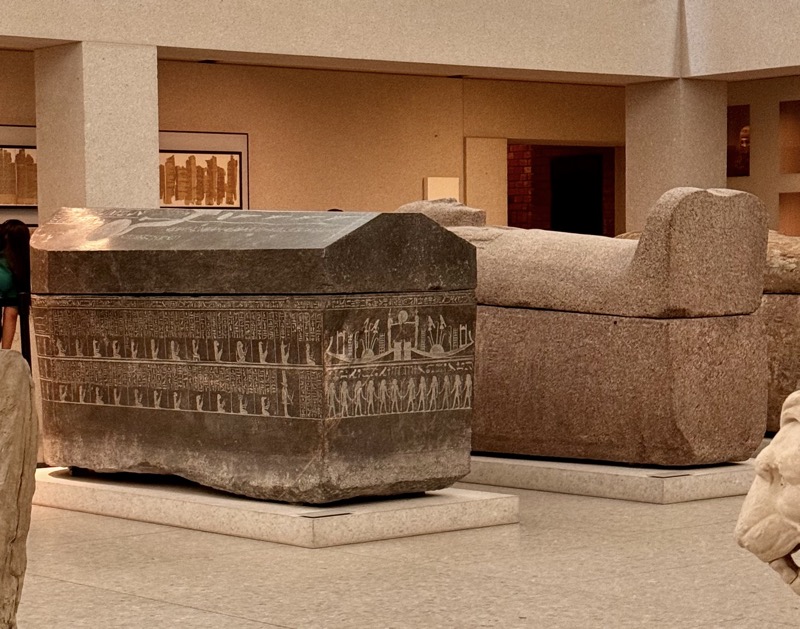
Book of the Dead of the Mistress Keku hieroglyphic. Ptolemaic period, c.332-330 BC.
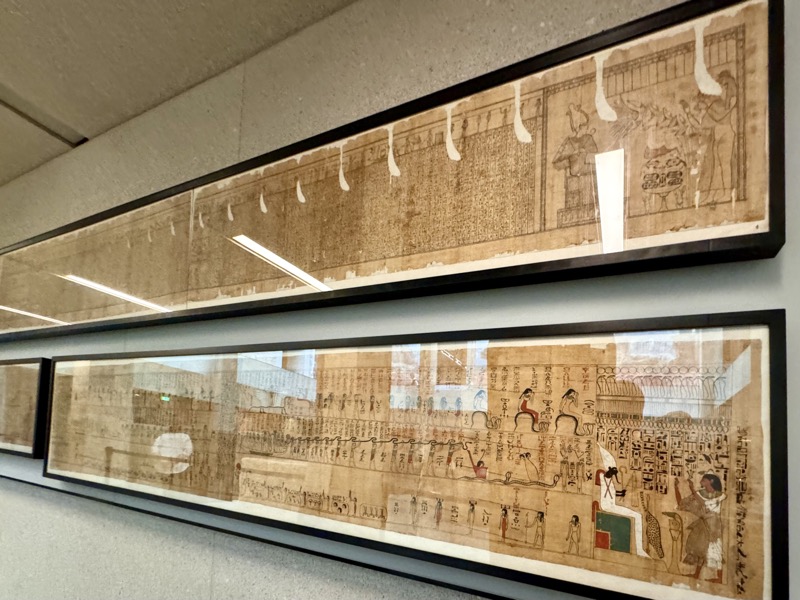
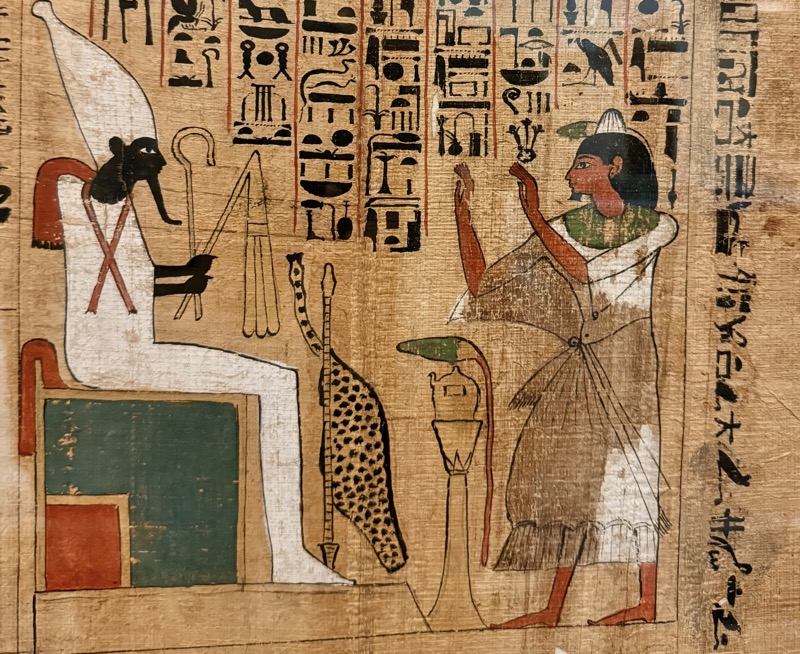
Stela of Hor praising the god Re-Harakhte. 3rd Intermediate Period, 22nd/23rd Dynasty, c. 946-722 BC.
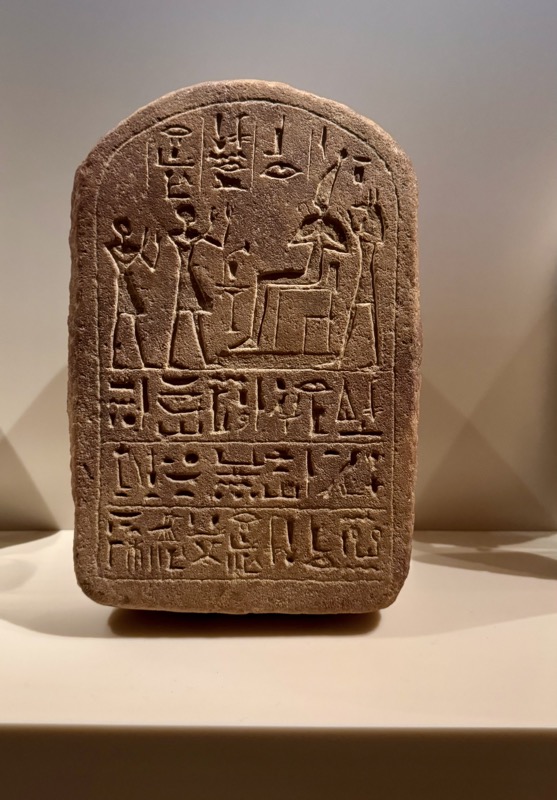
Funeral mask. Late period. 25th-26th Dynasty, c.750BC, Thebes West. Wood and painted.
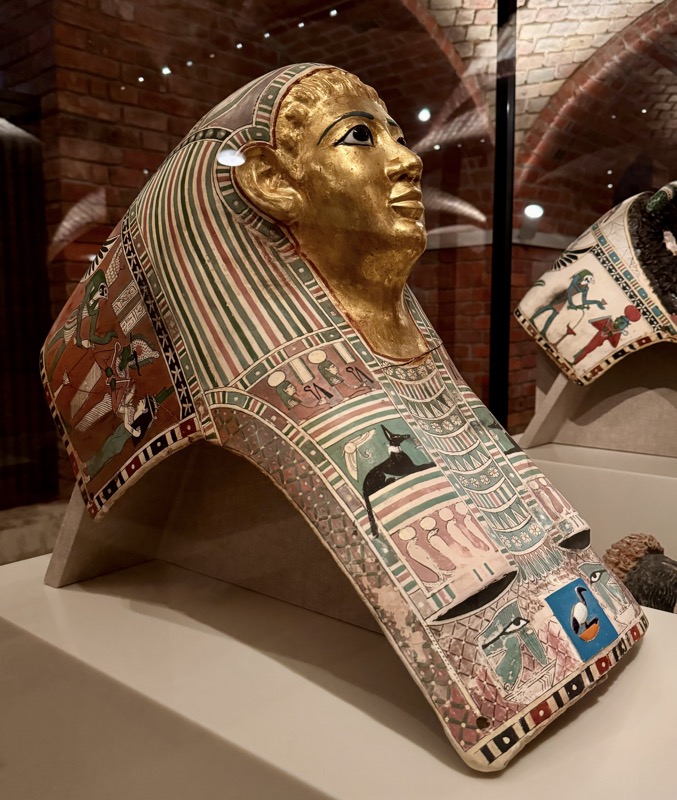
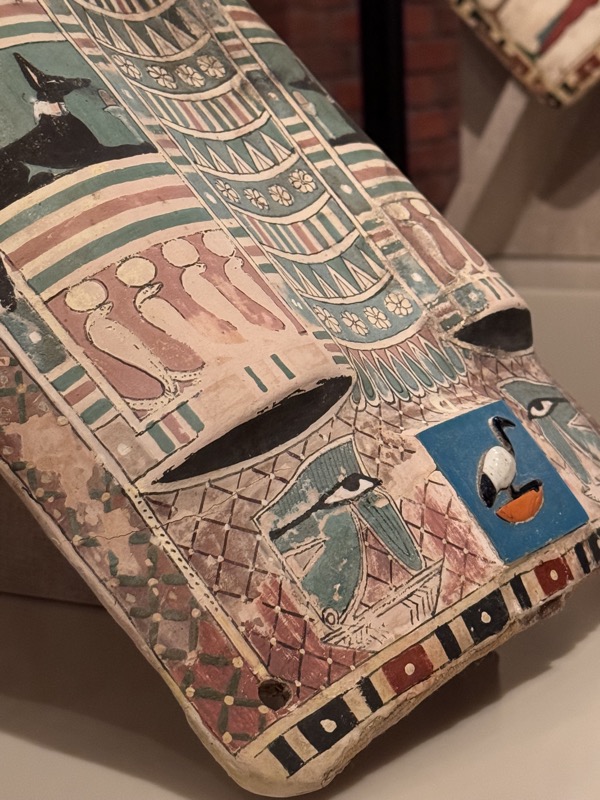
Anthropomorphc coffin of Hatbor-Ibet, with winged goddess. Late Period – Early Ptolemaic Period, 400-200 BC, Abusir el-Meleg; wood, primed, painted
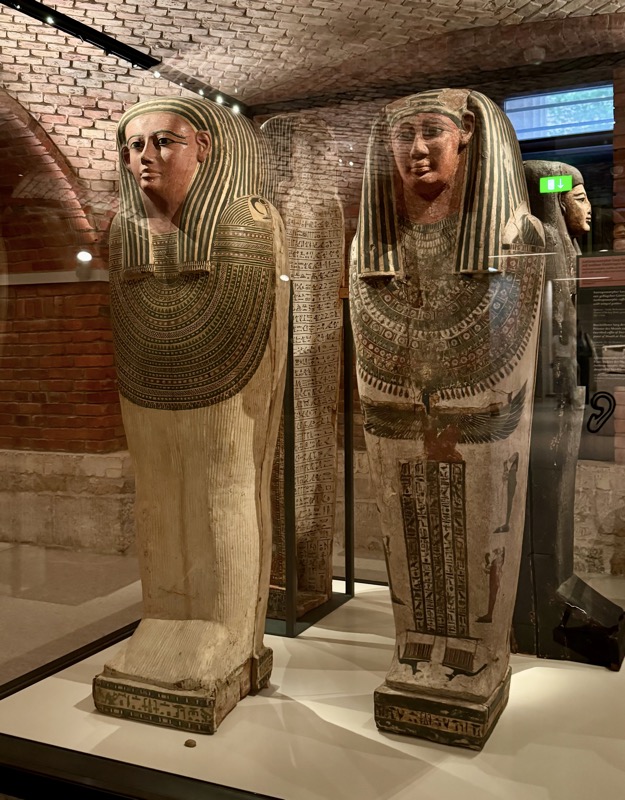
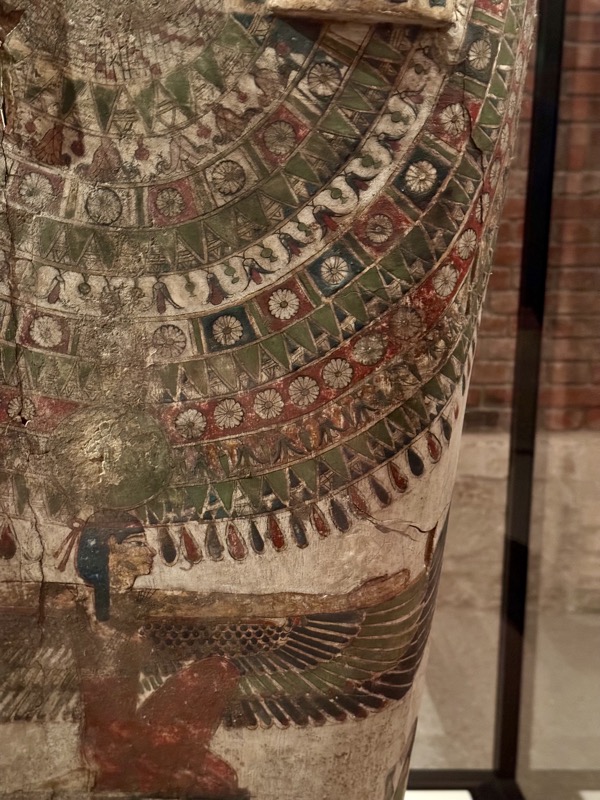
Lid and case of the coffin of the woman Hat, Ptolemaic, c.332-30 BC
Akhmim; wood, stuccoed and painted.
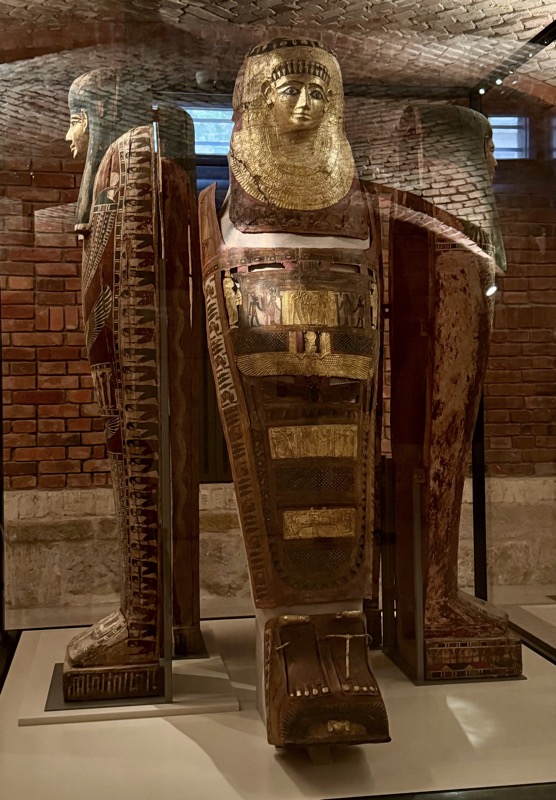
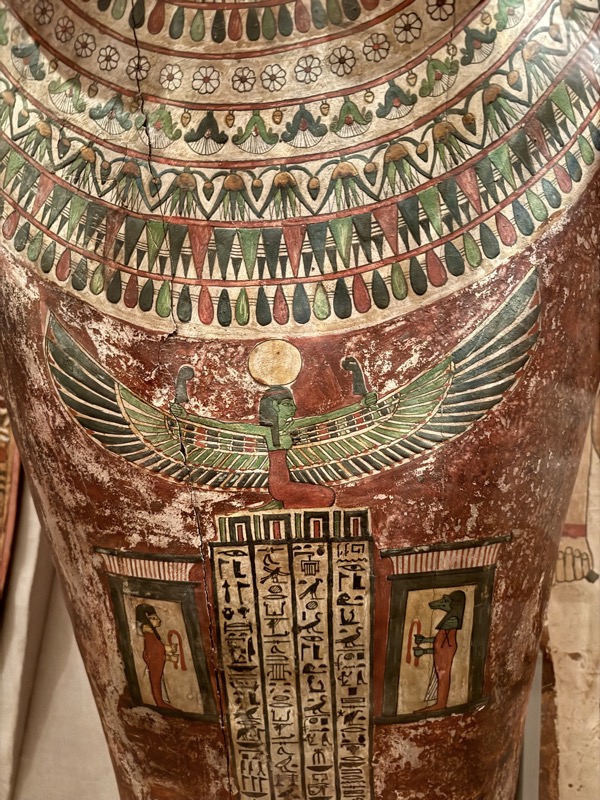
God Anubis in the shape of a lying jackal.
Middle coffin of Mentuhotep, outer surface decorated with pairs of eyes.
Inner coffin of Mentuhotep, inner and outer surface decorated.
Burial goods: model of rowing boat with crew; female offering bearer; bowl and three jars for beer.
All Middle Kingdom, 12th Dybasty, c.1800BC, painted timber objects and pottery.
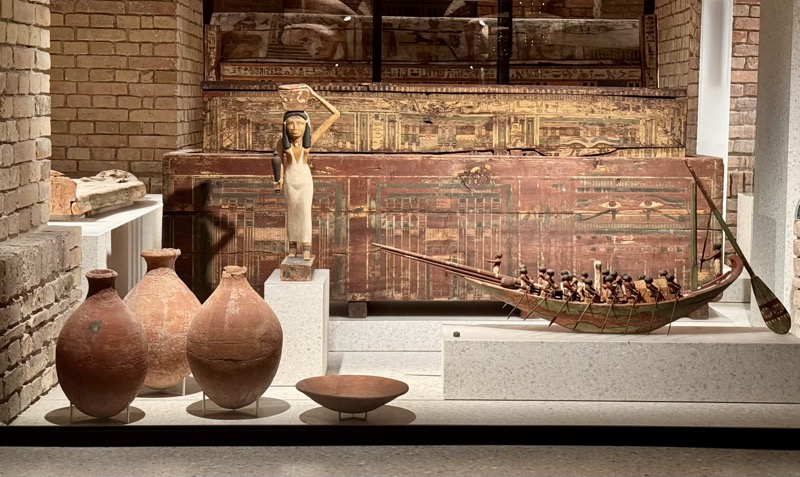
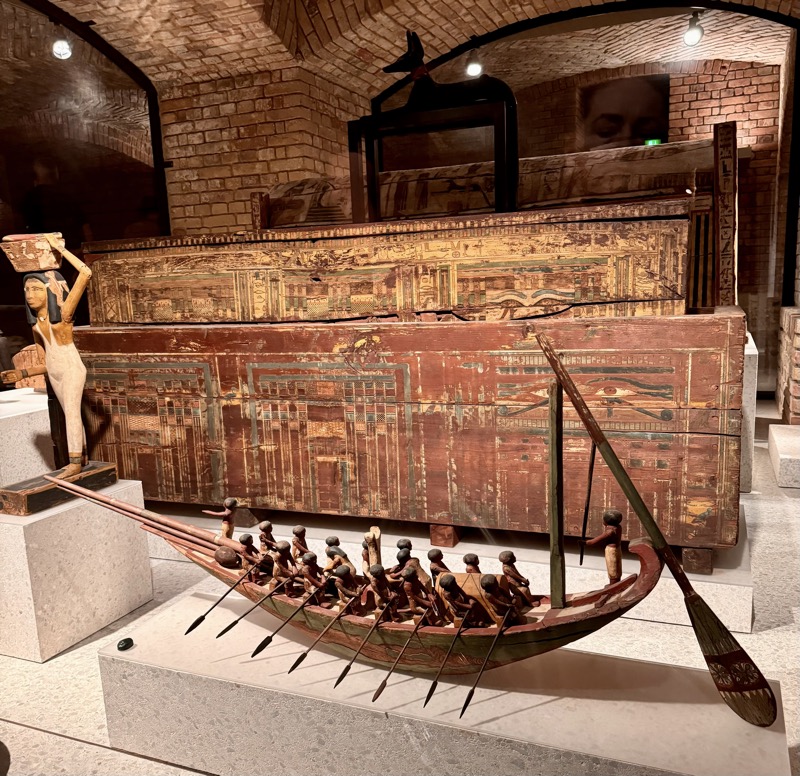
Family Burial: mummy mask of Aline and Mummies of three daughters of Aline.
Roman Imperialist period, 100-200AD, Tempera painting on canvas.
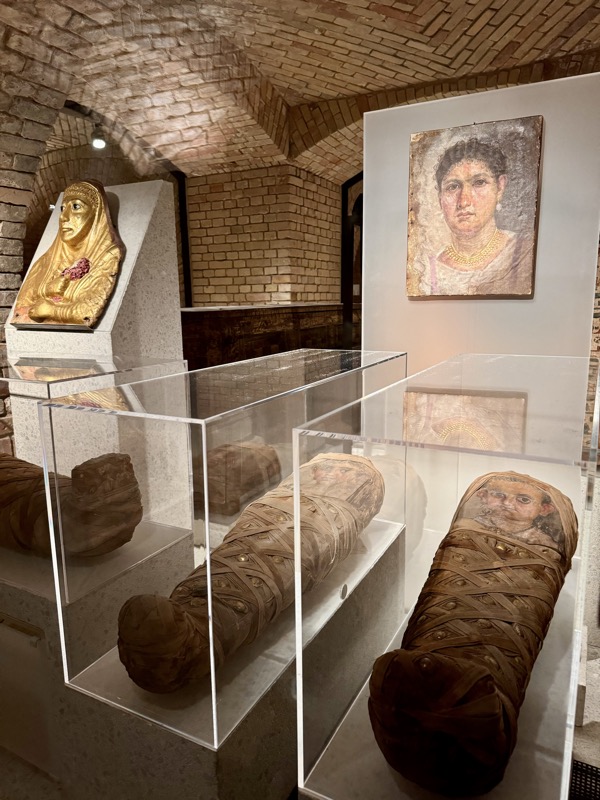
Four canopic jars (jars for entrails) with lids in the style of the four sons of Horus (protective deities),
3rd Intermediate Period, 21st-24th Dynaasty, c.10th-8thC BC, limestone.
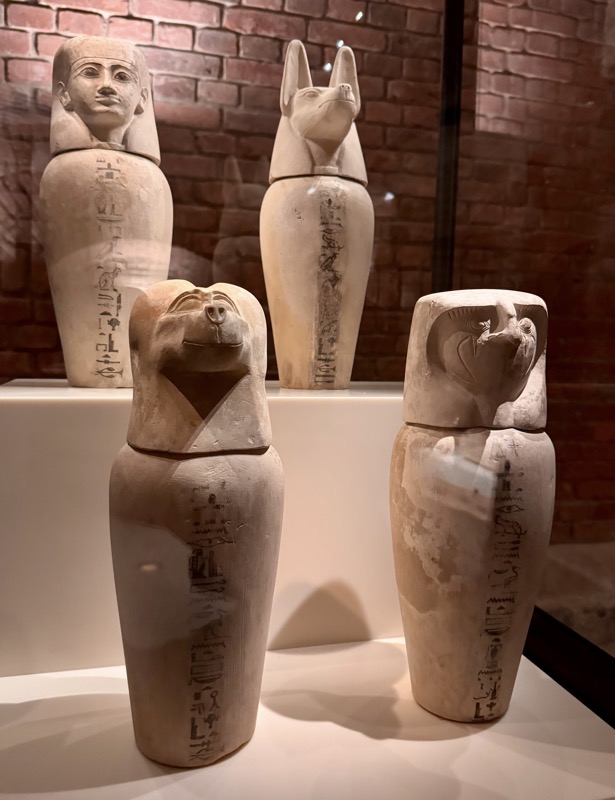
Shanti without inscription and shabti of Nefer-in-Ra-Neith from his tomb.
3rd Intermediate Period, 22nd/23rd Dynasty c.945-715 BC, & Late period 26th Dynasty, c.570-526 BC.
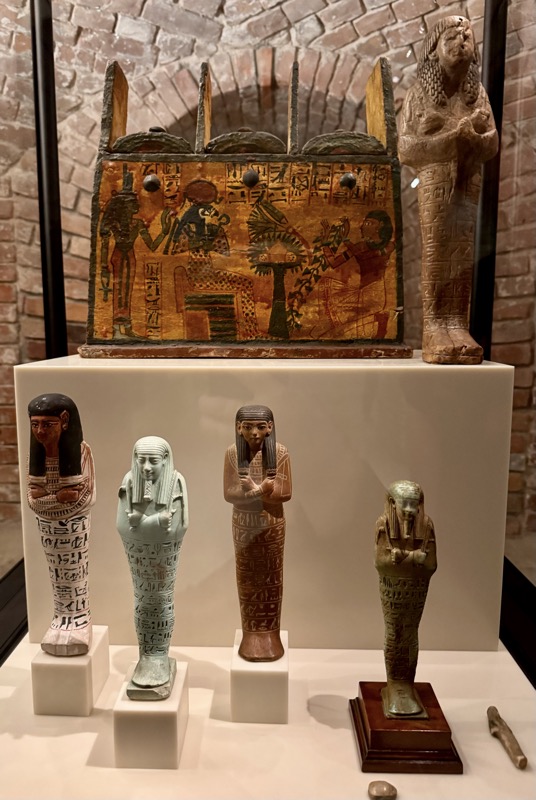
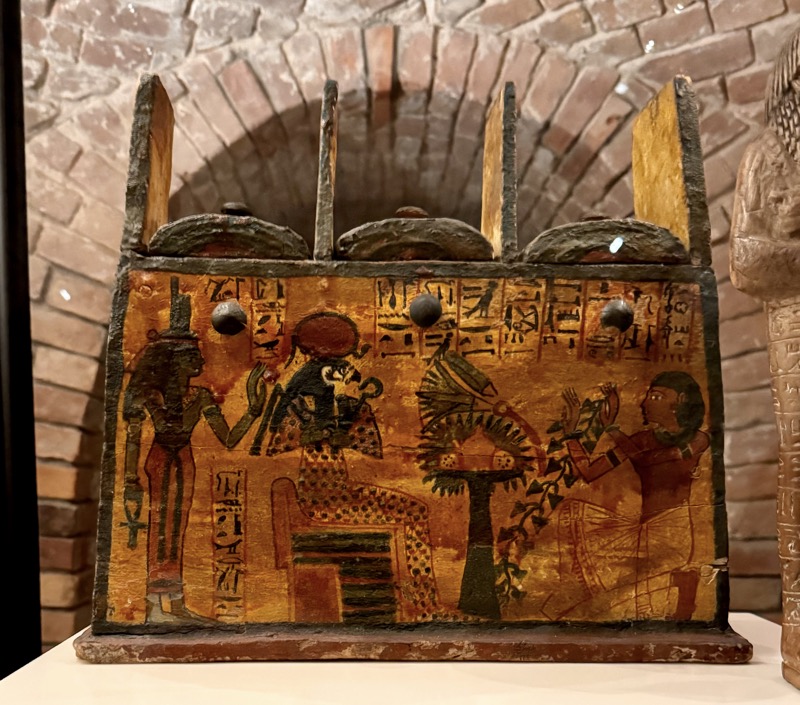
Crocodile with snap-action mechanism.
New Kingdom, c.1540-1075 BC. Thebes, wood.
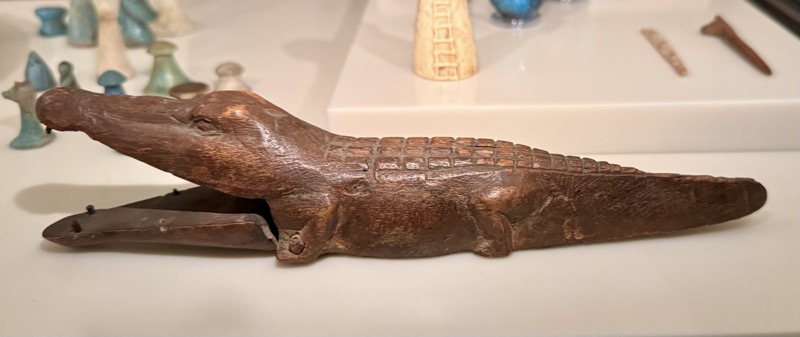
Base for a barque of the royal couple, Natakamani and Amanitore,
Meroitic Period, c.1-25AD, Wad Ban Naga Isis Temple, sandstone.
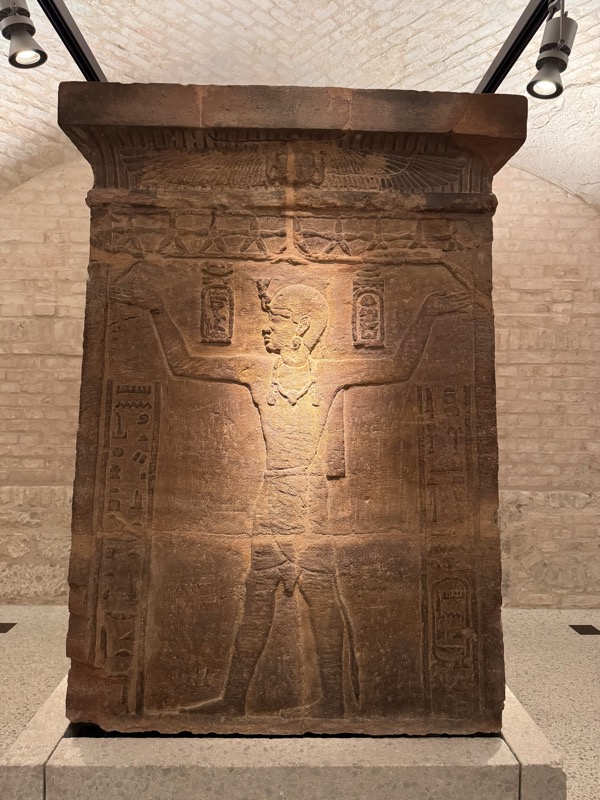
Stela, King Nastasen and his mother in front of the god Amon, c.330BC, granite.
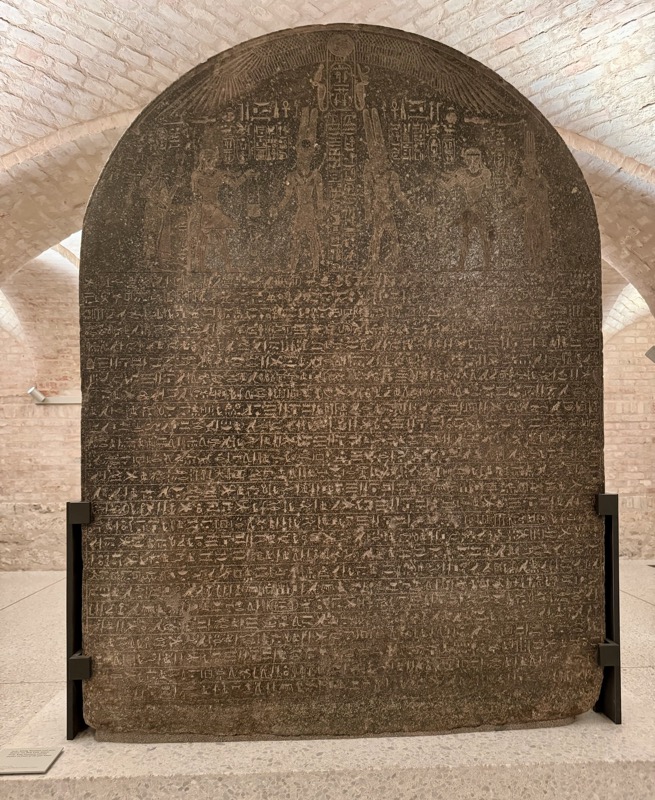
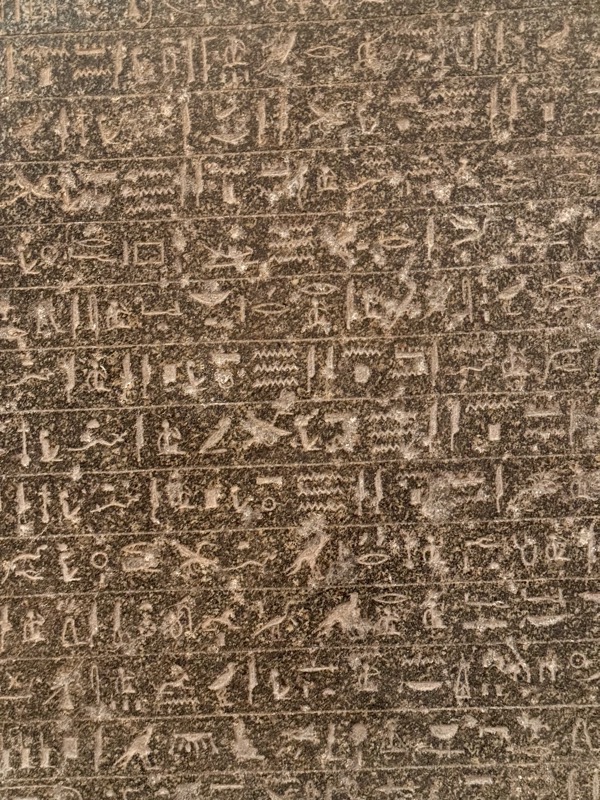
Statue of a squatting hawk, upper part modern supplemented, donated by pharaoh Amenhotep III,
New Kingdom, 18th Dynasty, c.1388-1351 BC.
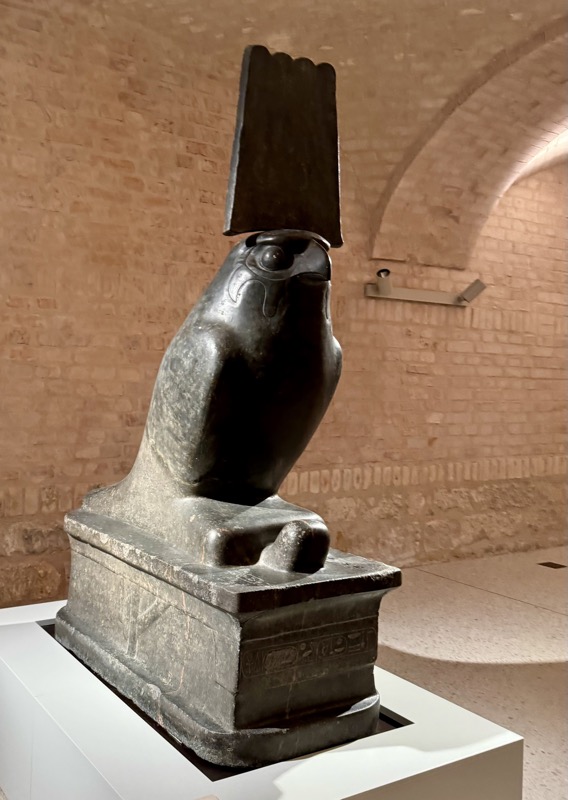
Necklace, rings and scaraboid.
Gold, bronze, gilded, faience, semi-precious stones, c.5th-4thC BC, Cyprus.
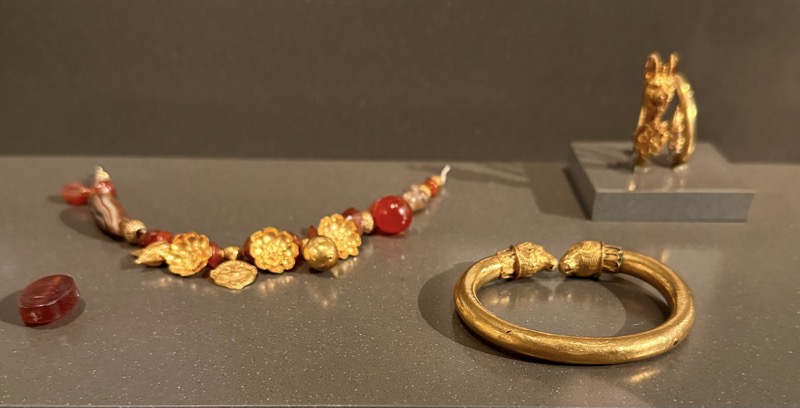
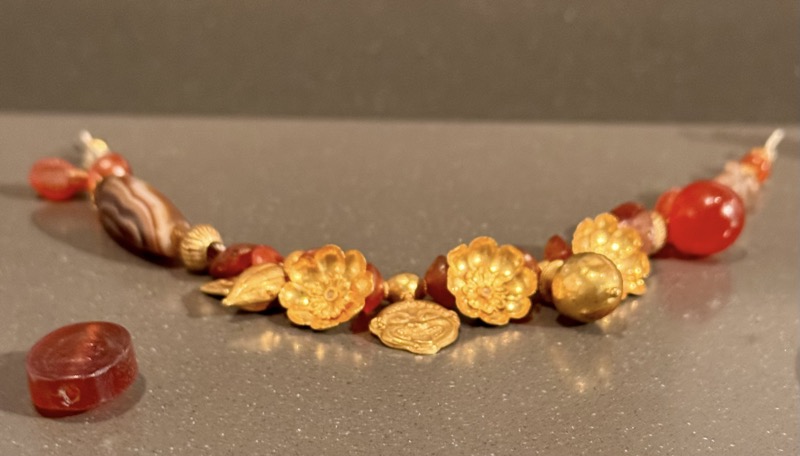
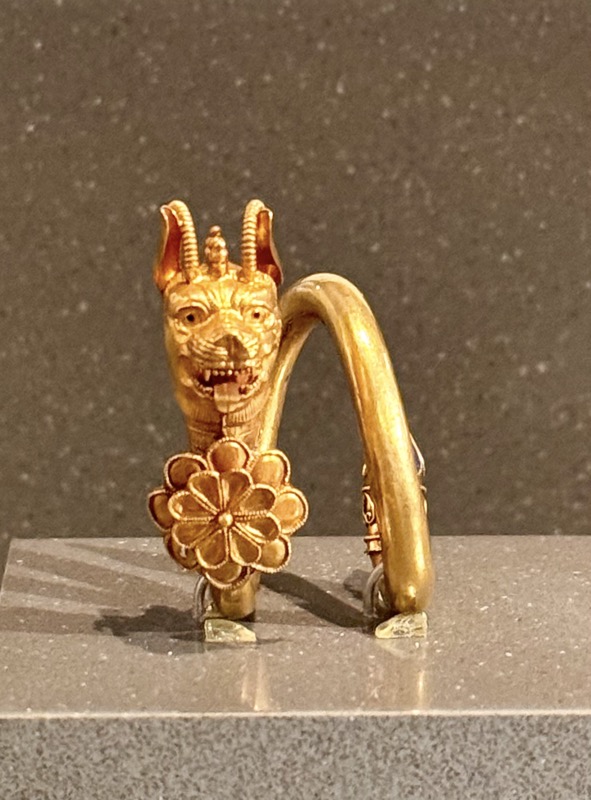
Finger ring with Phoenician scarab, gold and glass, c.500 BC.
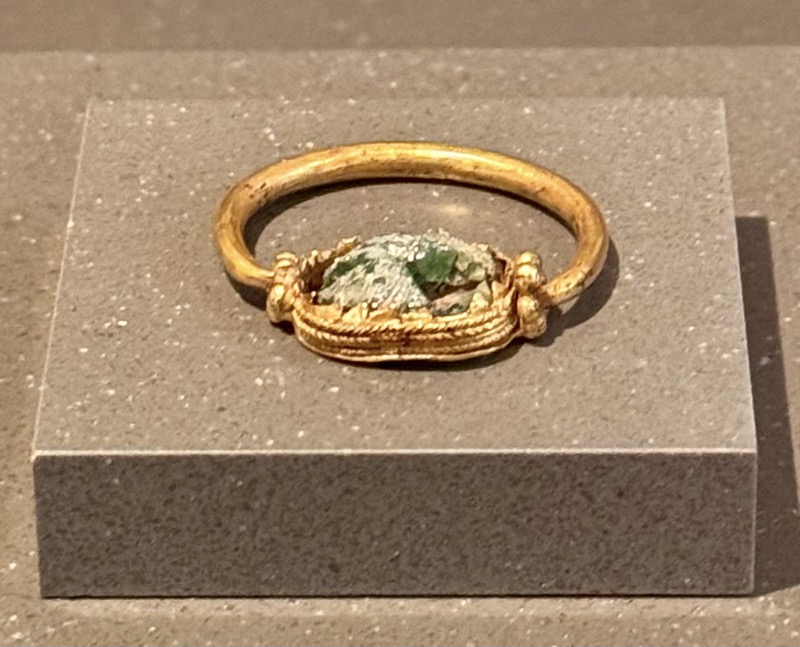
Urn of indecipherable description.
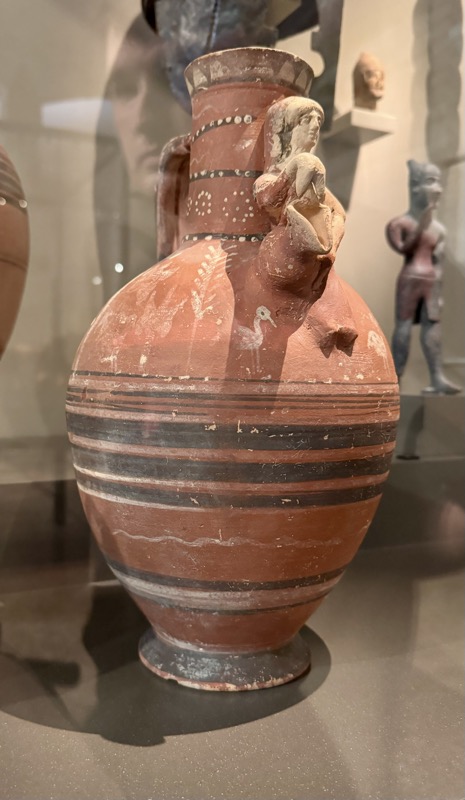
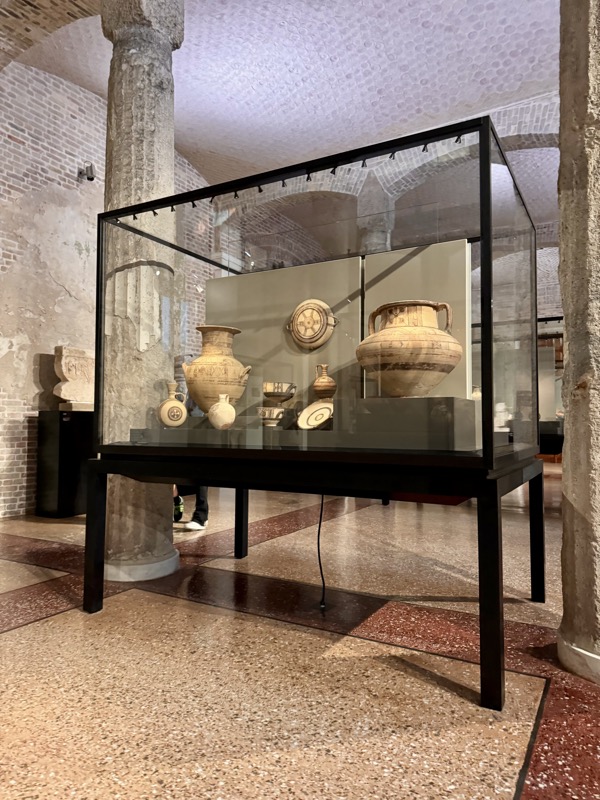
Wheeled stand for a cauldron. Bronze, c. 12–11thC BC.
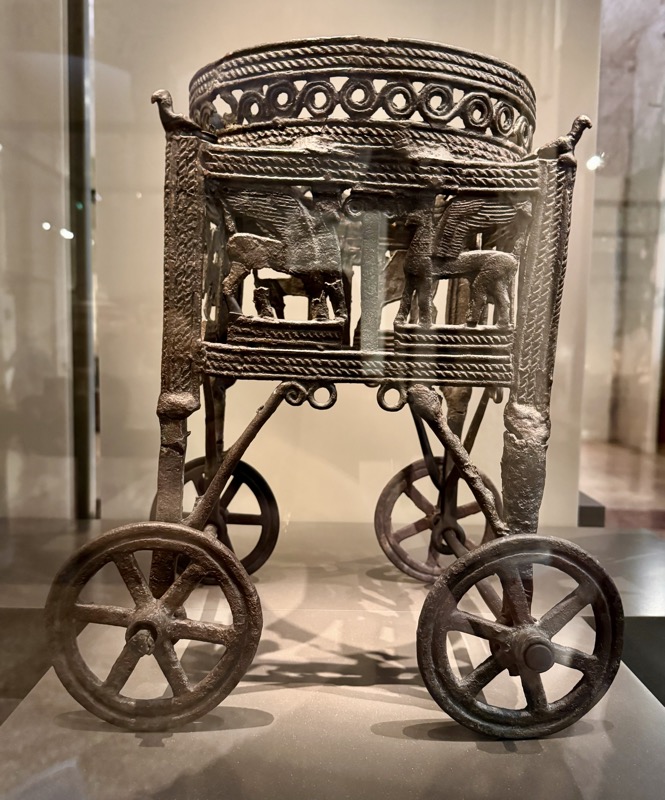
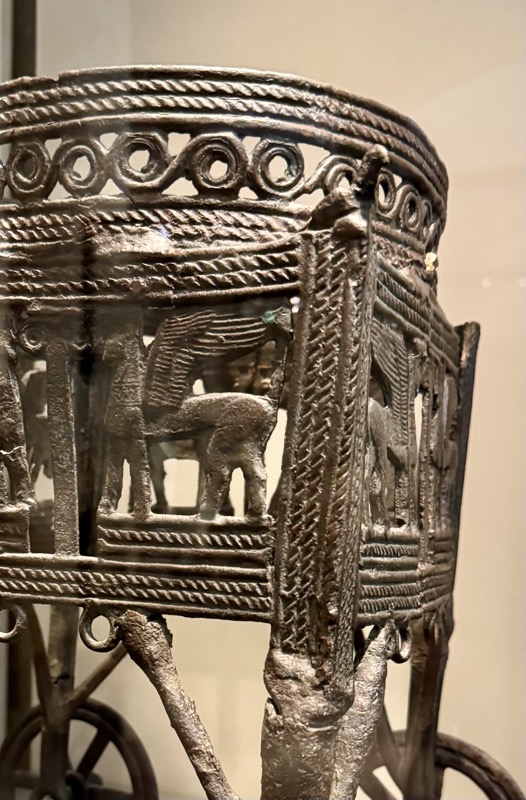
Diadems, gold- silver plated, mid-3rd millennium BC, Treasure of Priam.
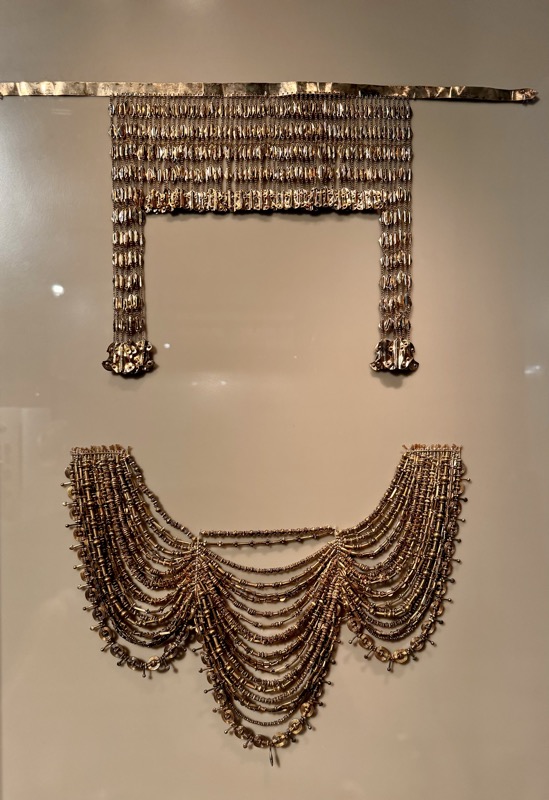
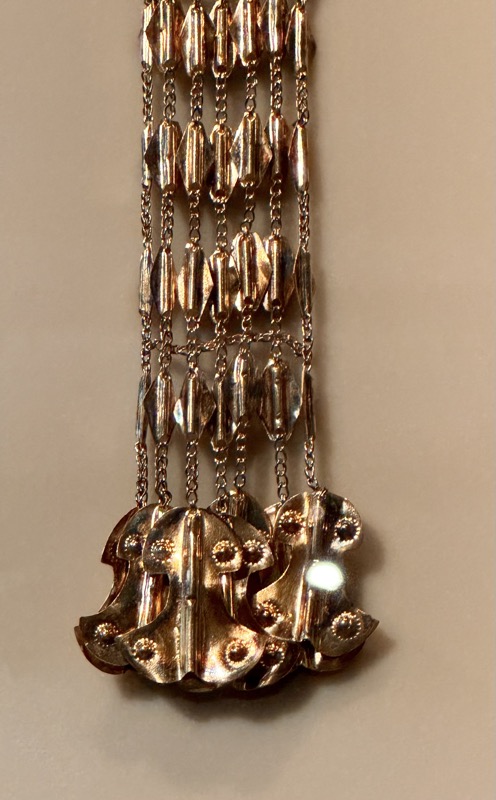
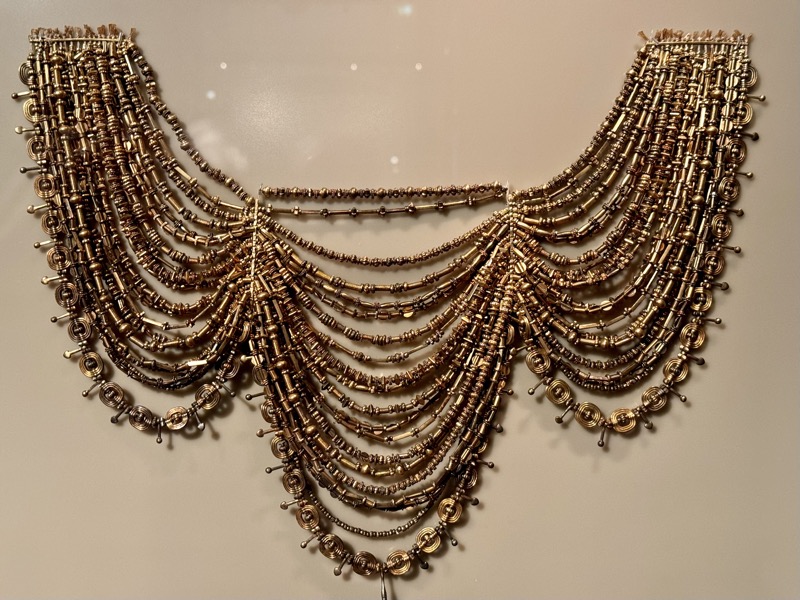
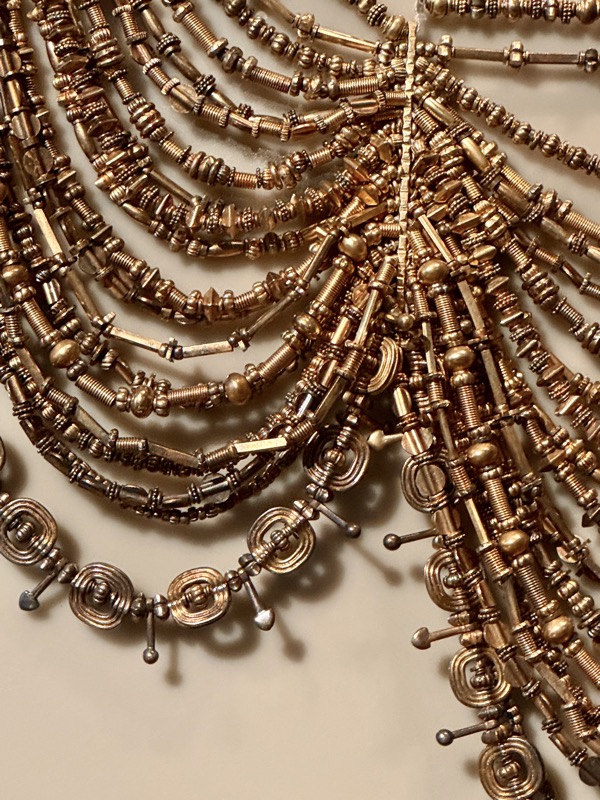
Ear pendants, gold, silver gilded, mid-3rd millenium BC, Treasure of Priam.
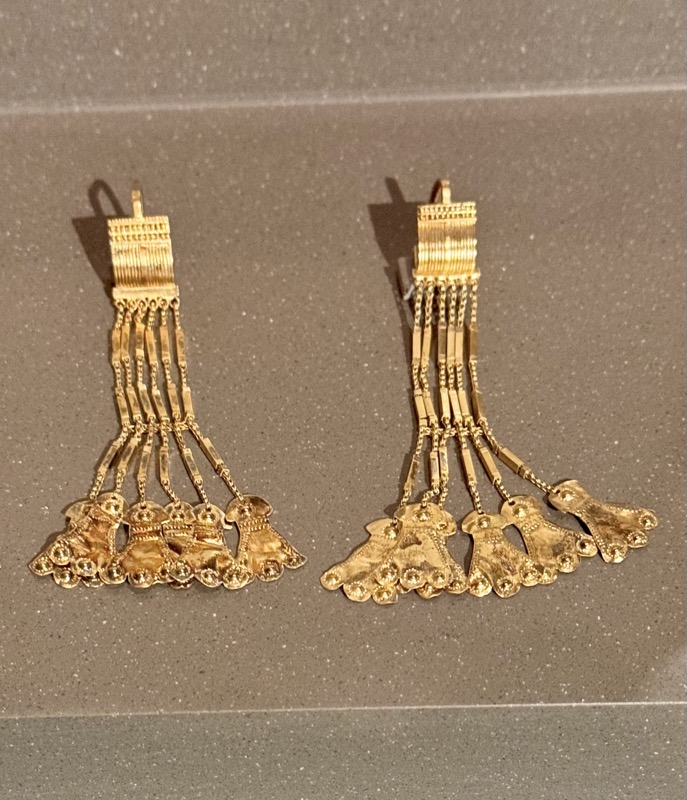
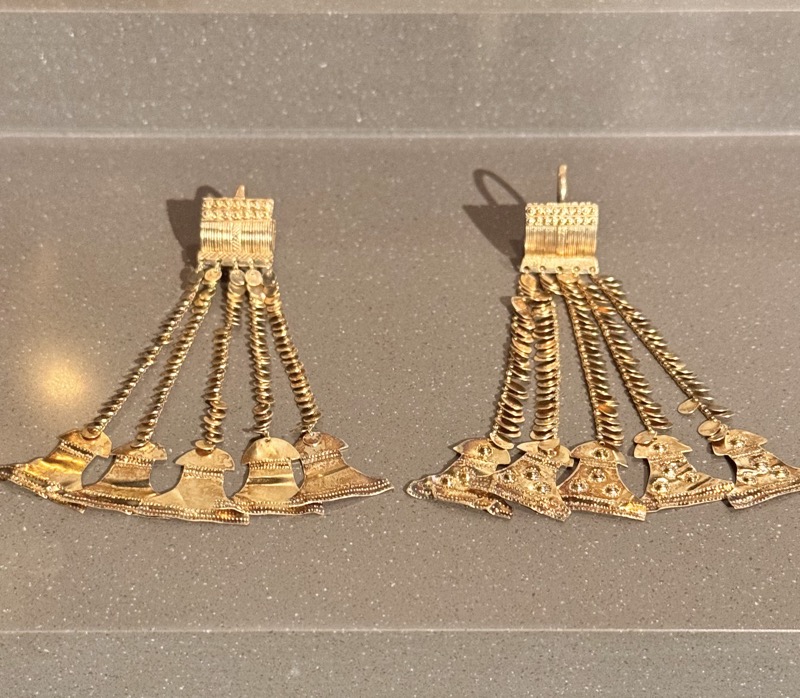
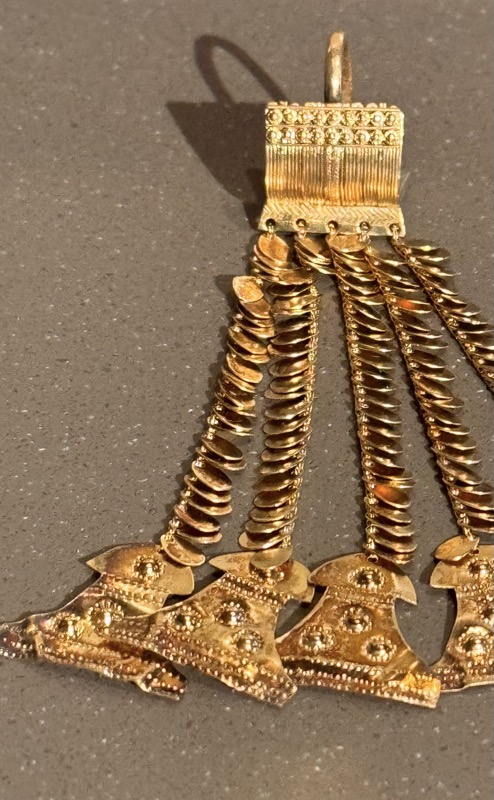
Bracelets, earrings or hair-rings. Gold, gold plated silver, mid-3rd millenium BC. Treasure trove L.
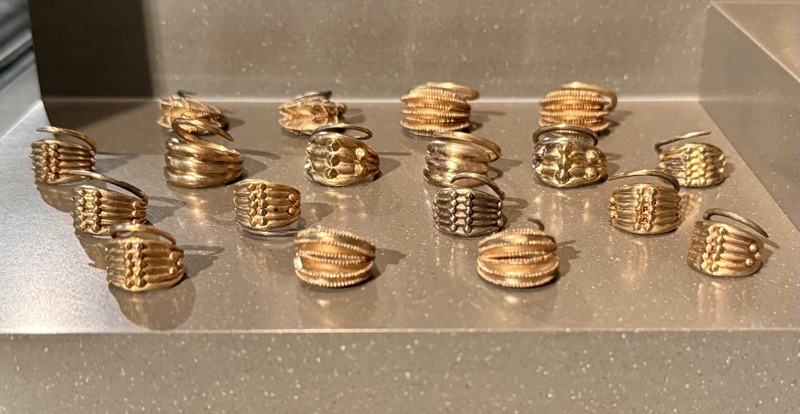
Armrings mentioned above:
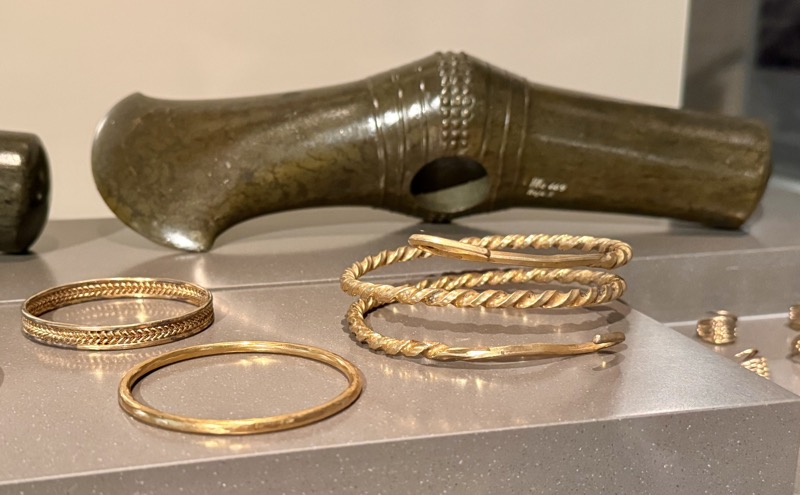
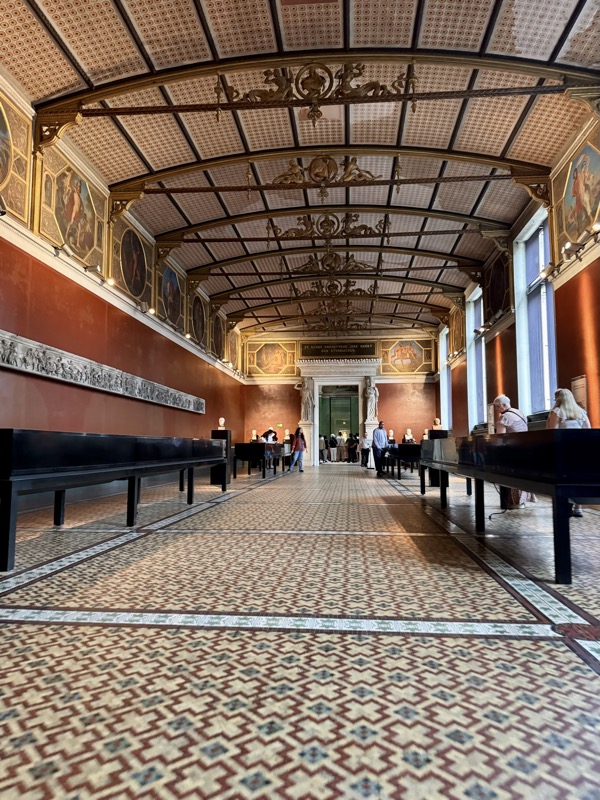
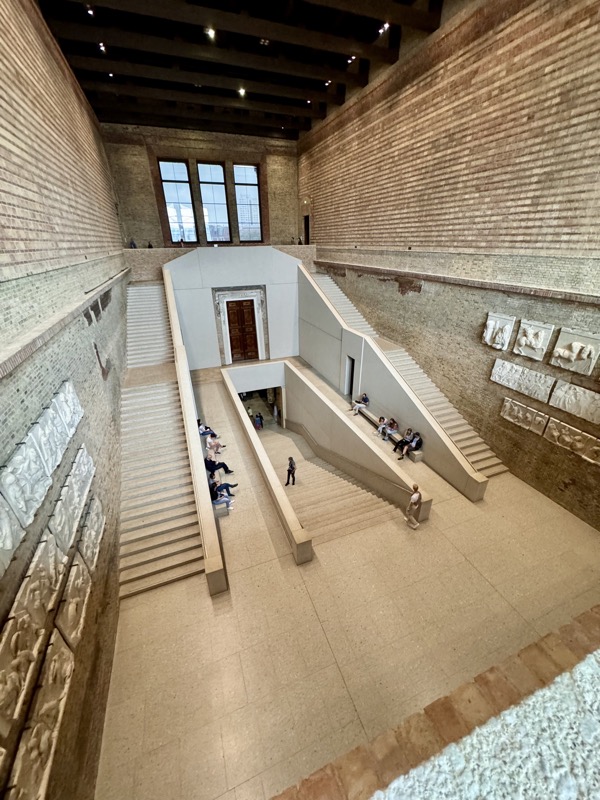
Bronze Age exhibits had zero English descriptions, so we didn’t loiter here long…
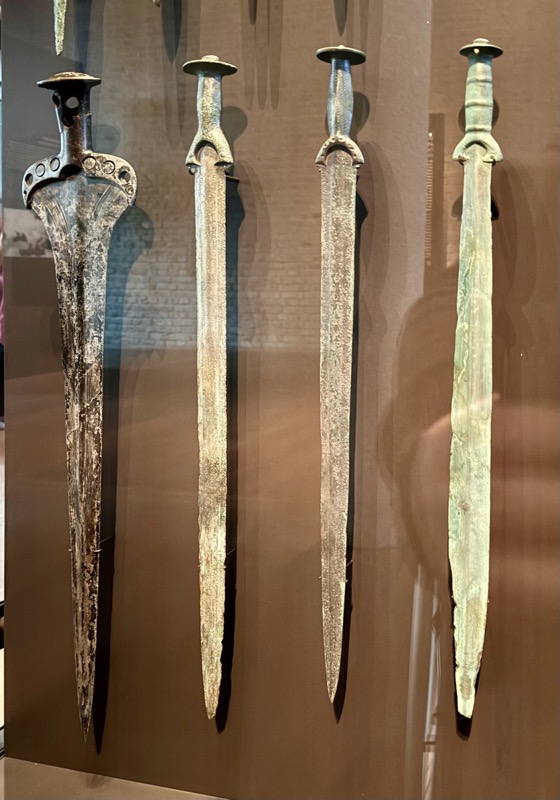
Very cool and old but more detail please!
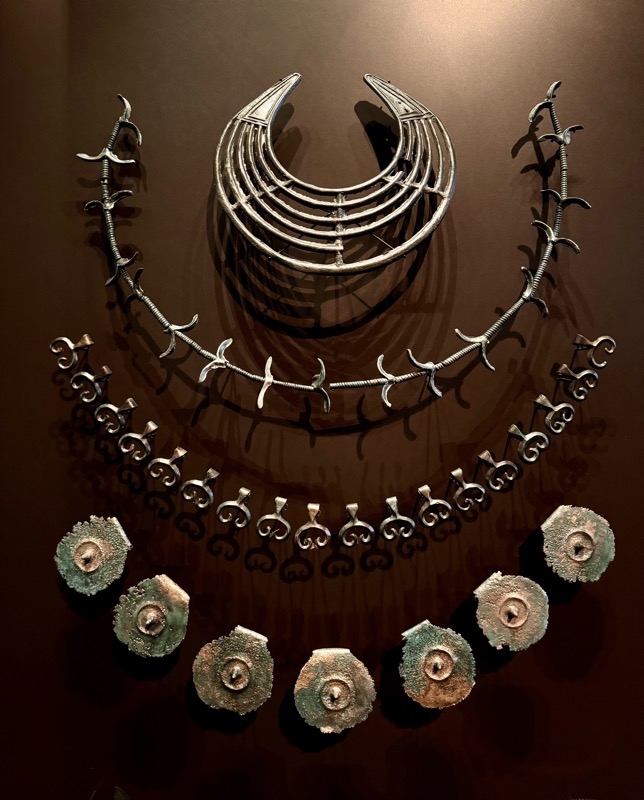
“Berlin Golden Hat”, Gold, c.1000 BC, location unknown, probably Southern Germany, and detail:
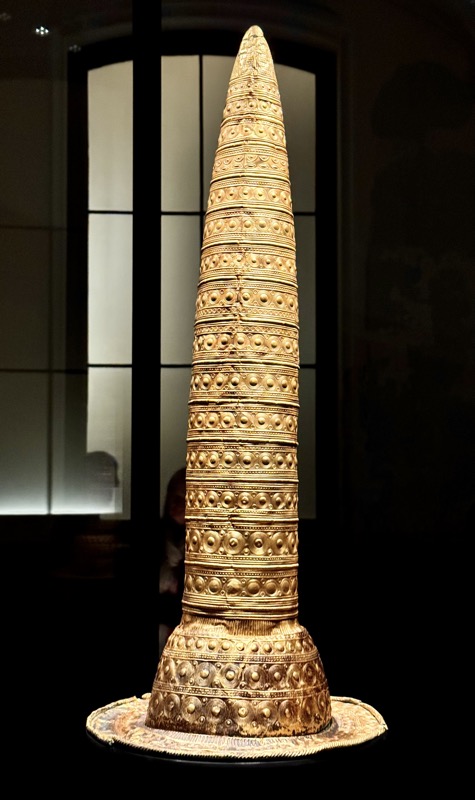
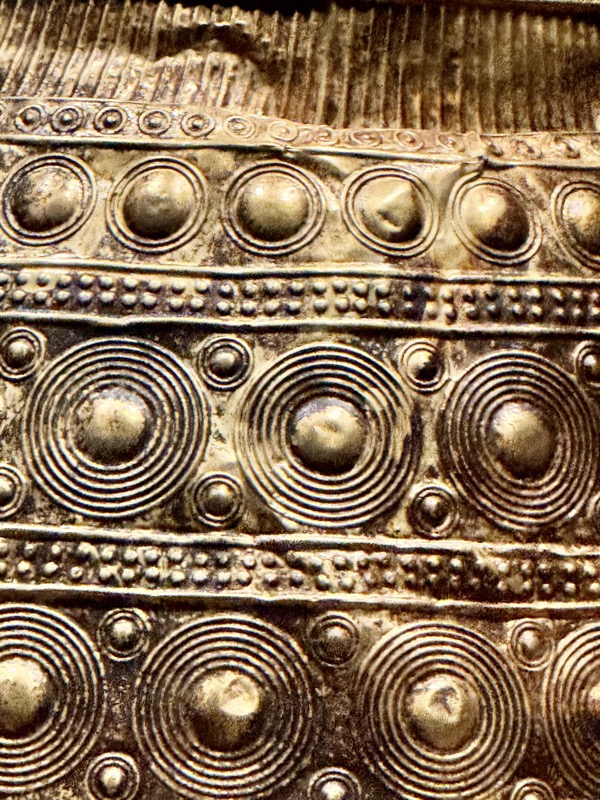
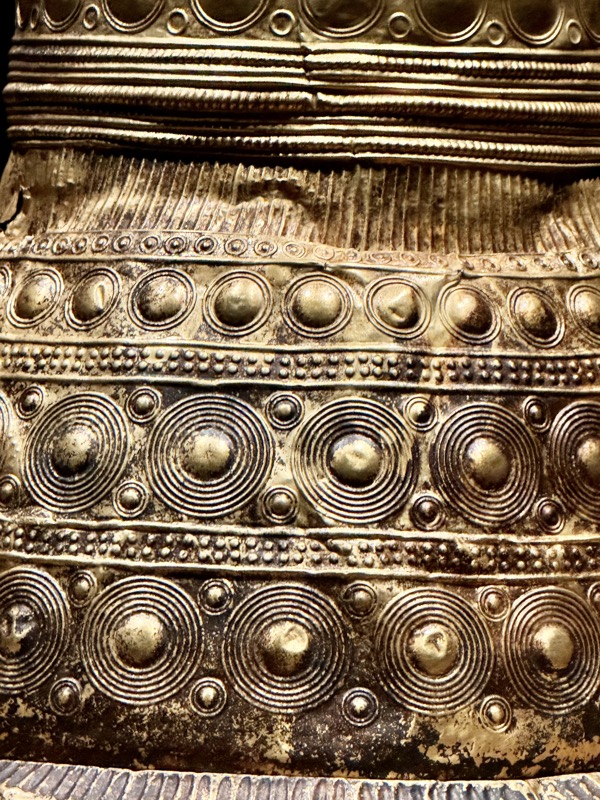
Bust of Nefertiti, one of the most famous art treasures of ancient Egypt. Considered a masterpiece of sculpture of the Amana period. Made during the reign of Pharoah Akhenaten, New Kingdom, 18th Dynasty, c.1353-1336 BC. No photos allowed, so stolen one from the internet!
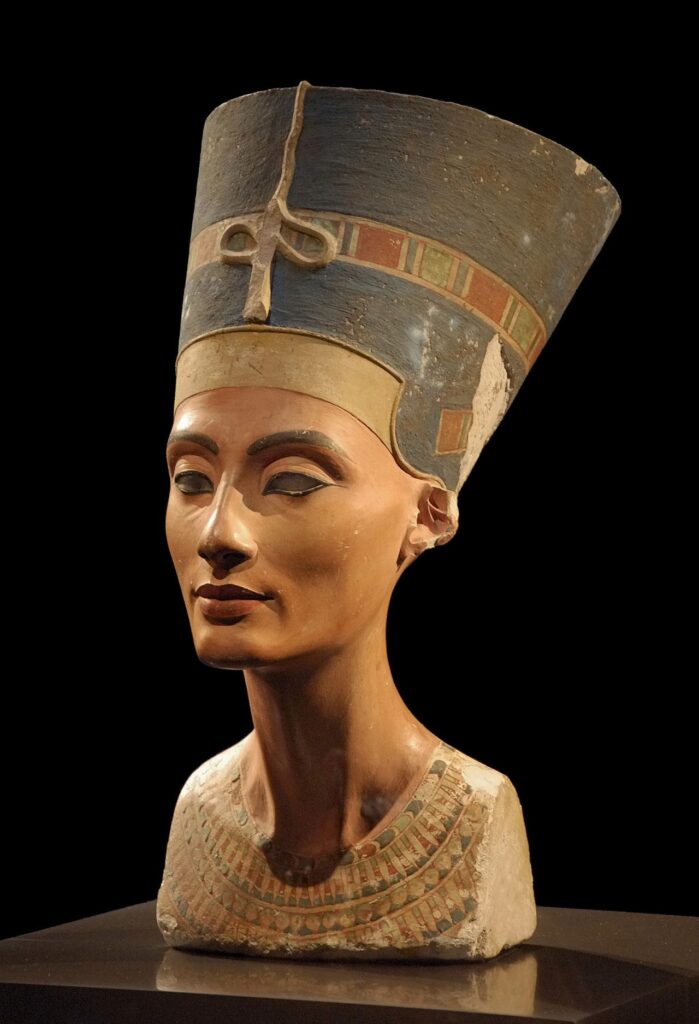
The museum was large, but due to the lack of English signage, and not having a huge interest in Egyptian artefacts, we weren’t there long. Outside and off to the Berliner Dom. The cathedral is nowhere near as awesome an imposing as the Aachen and Cologne cathedrals – possible because it’s just not as large, and also because well, it’s so new… all things being relative.
The Berlin Cathedral is located at the Lustgarten end of Museum Island. IT’s a Protestant church built between 1894 and 1905, in a Neo-Renaissance/Neo-Baroque style. It is the largest Protestant church in Germany and has lots of important dead people in it. 😀
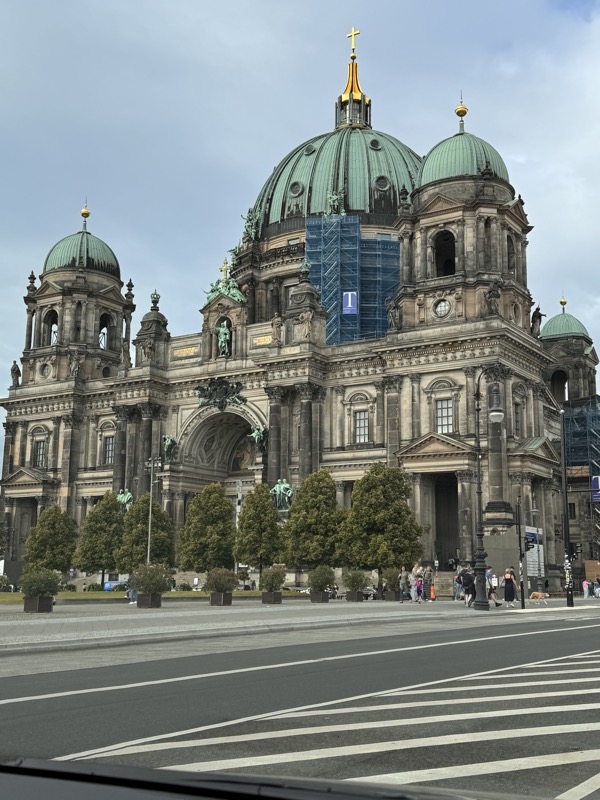
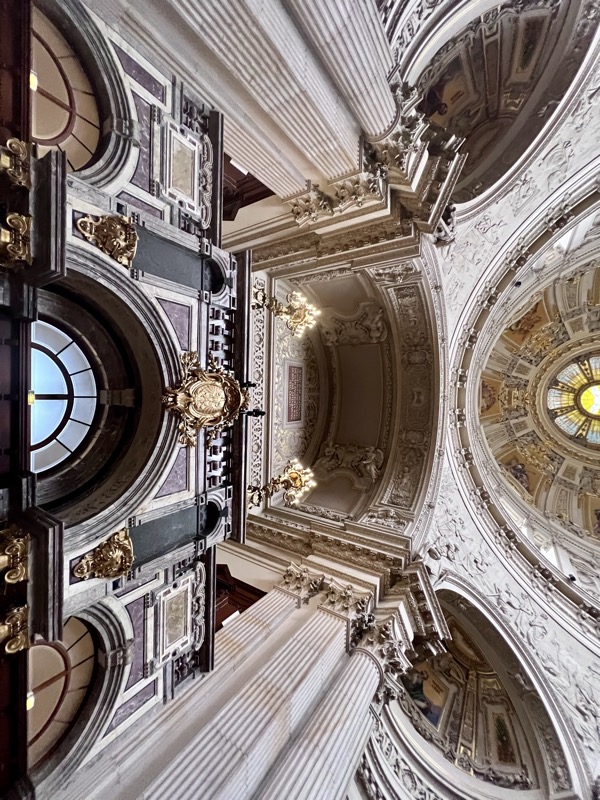
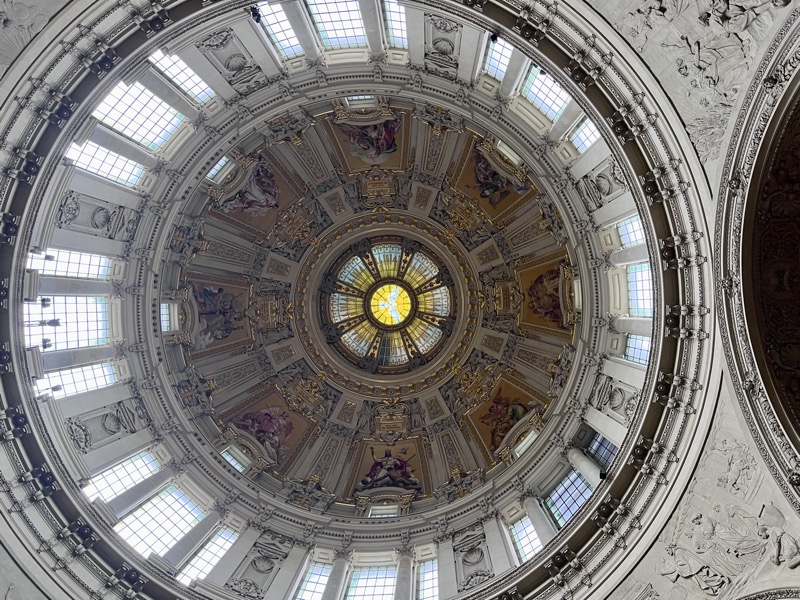
In WWII the cathedral was severely damaged. Allied air raids on the nearby area of Burstrasse, saw all the altar windows destroyed and large cracks in the dome, and corner towers. Later in 1944, during some of the worst air raids in Berlin, the dome and its lantern were heavily damaged. A canister with liquid fuel set fire to the wooden cladding that lines the copper roof as insulation. Firefighters apparently couldn’t reach it and the entire dome fell into the cathedral, going through the floor and into the crypt below. Urban legend says that a cathedral organist Fritz Heitmann kept playing even with the dome totally destroyed and open. After the war, the cathedral was assessed to by about 25% destroyed, and then looters caused even more damage – stealing pipes form the organ etc.
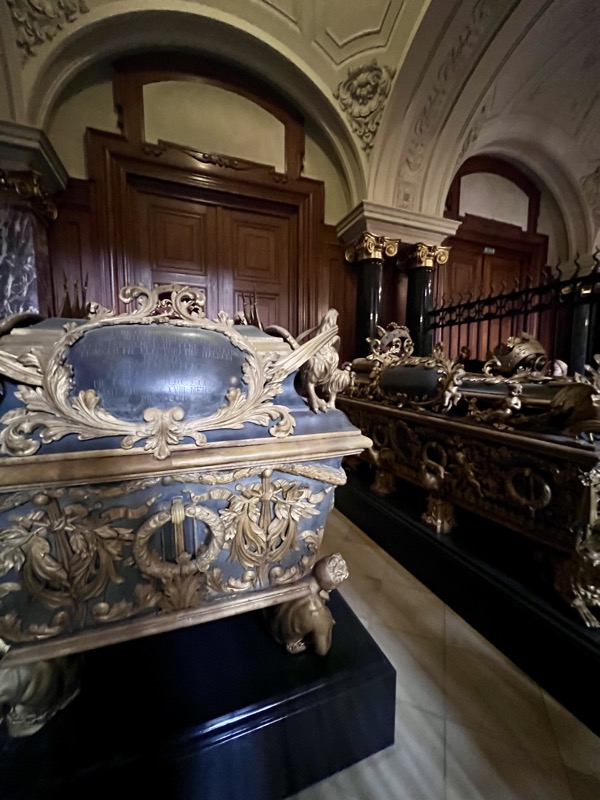
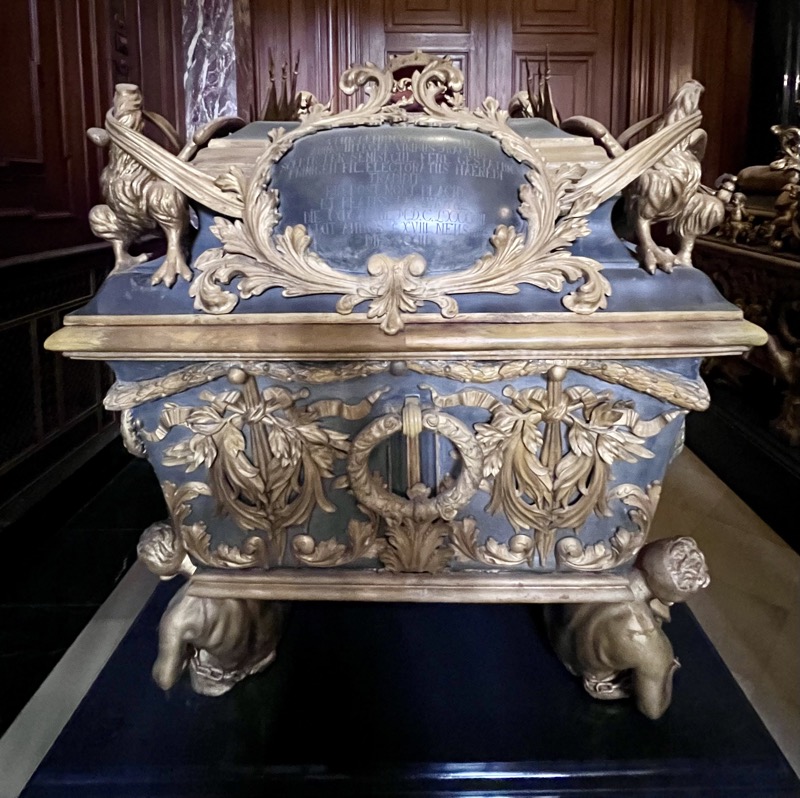
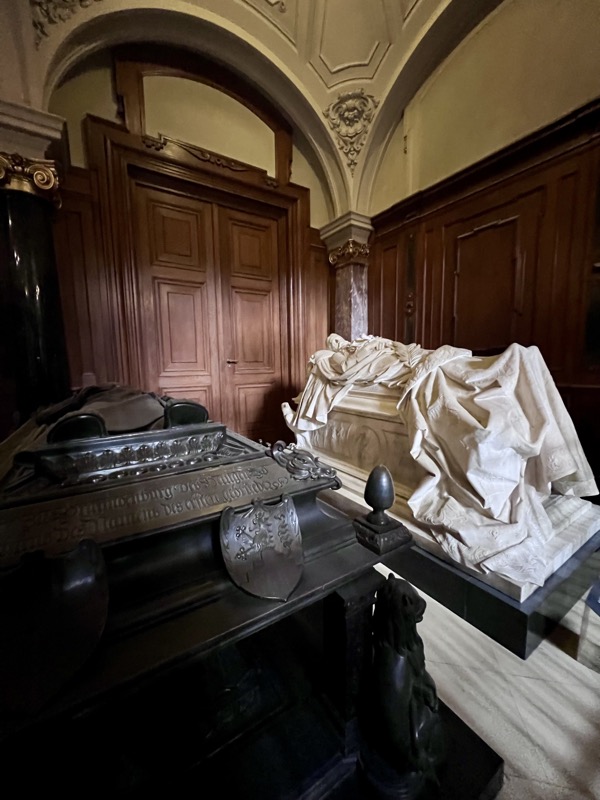
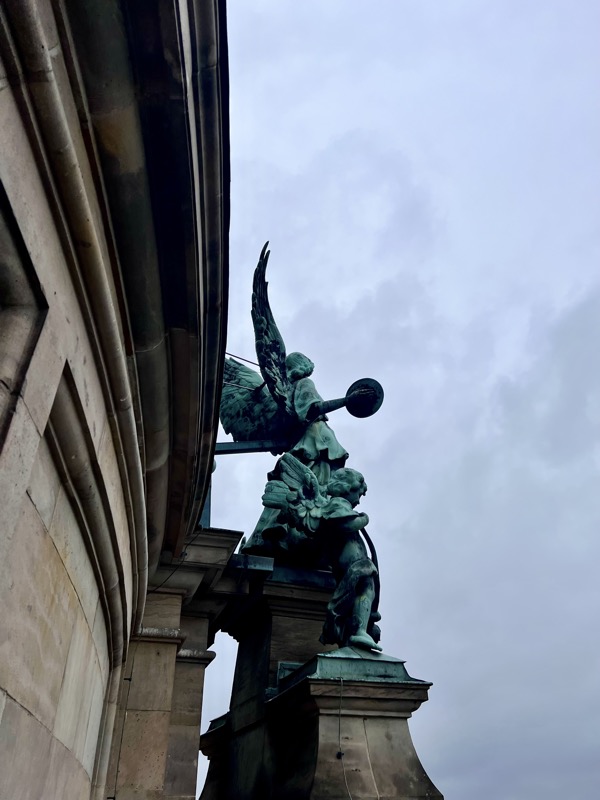
There are 270 steps to the top of Berliner Dom – needless to say, these are Angus’ photos.
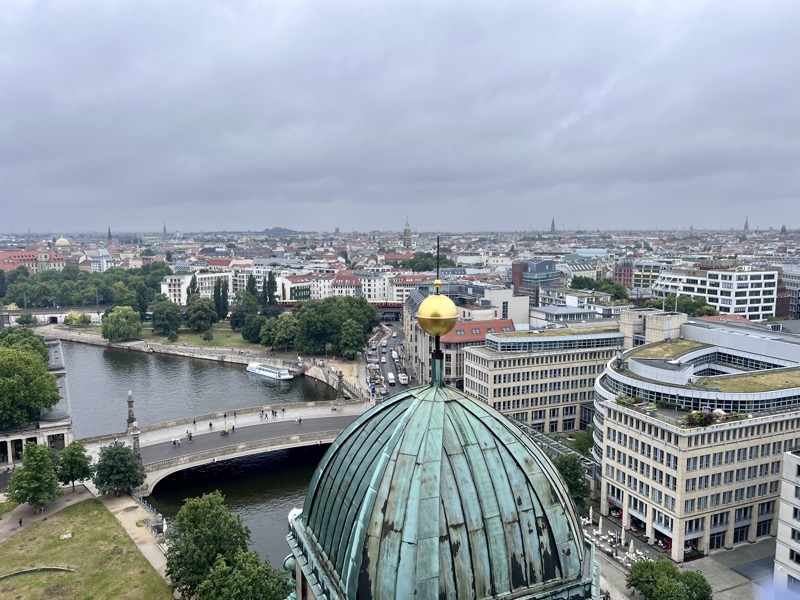
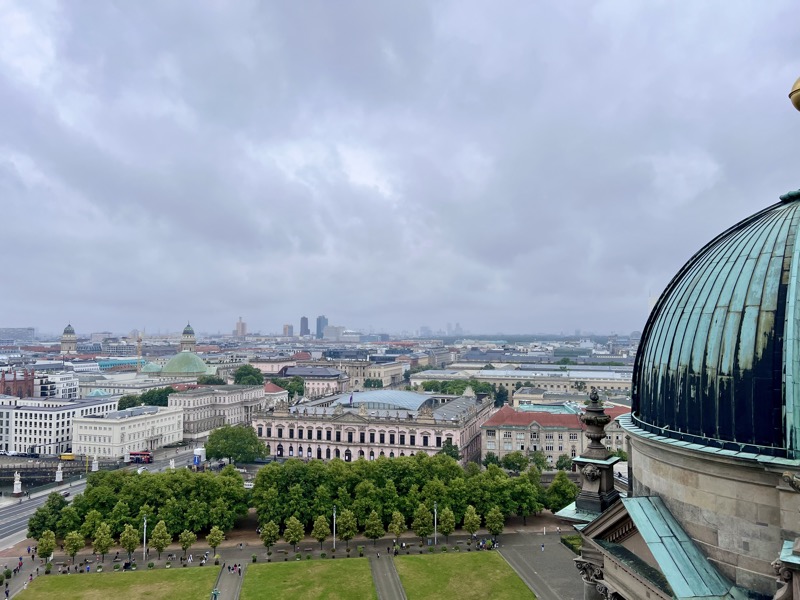
Reconstruction on the cathedral didn’t commence until 1975 when funds and expertise became available at a cost of some 150M Deutschmarks. At the moment, the facade of the cathedral is undergoing renovations at a cost of some €1.6M. :/
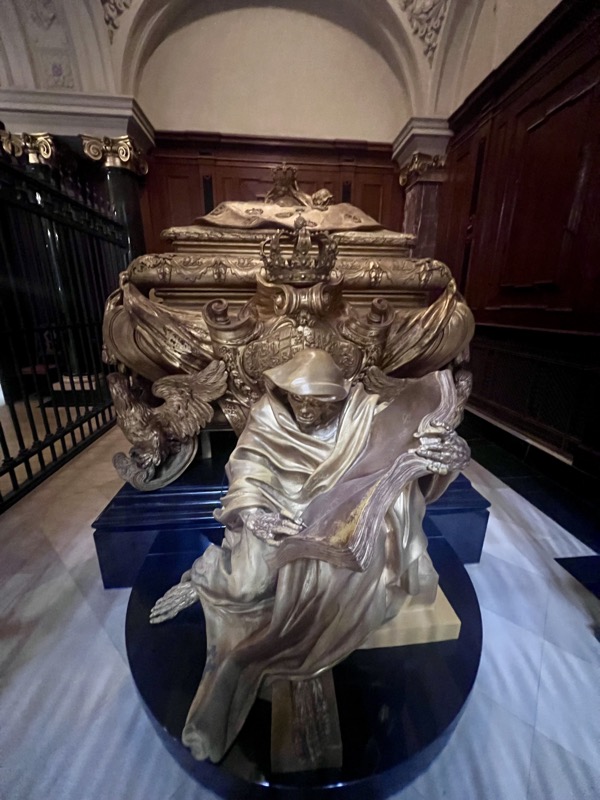
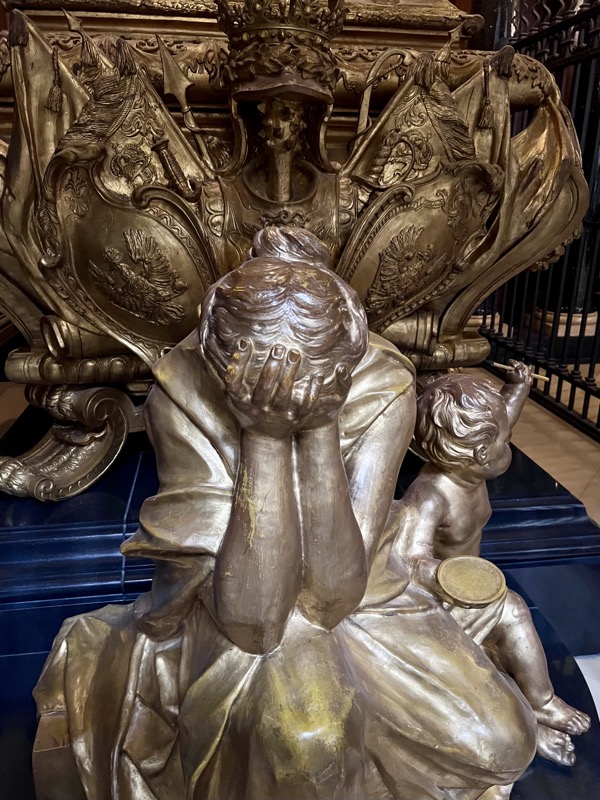
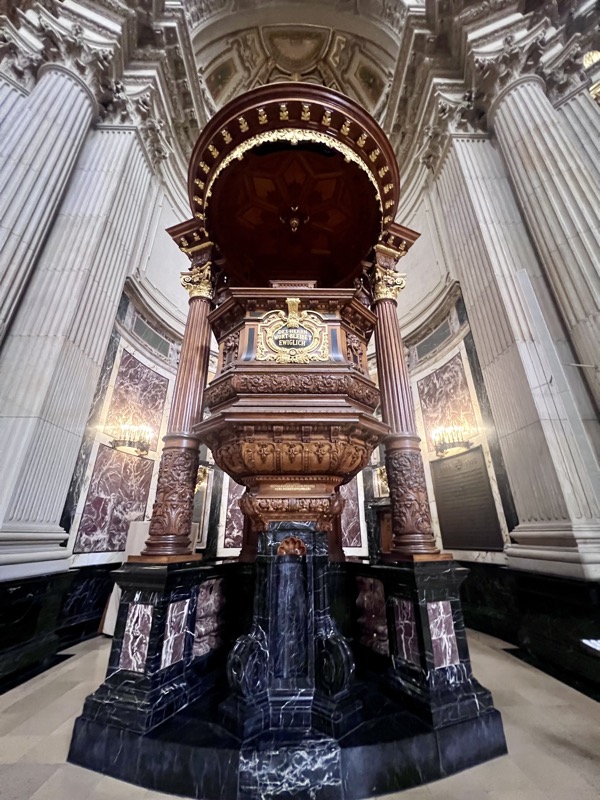
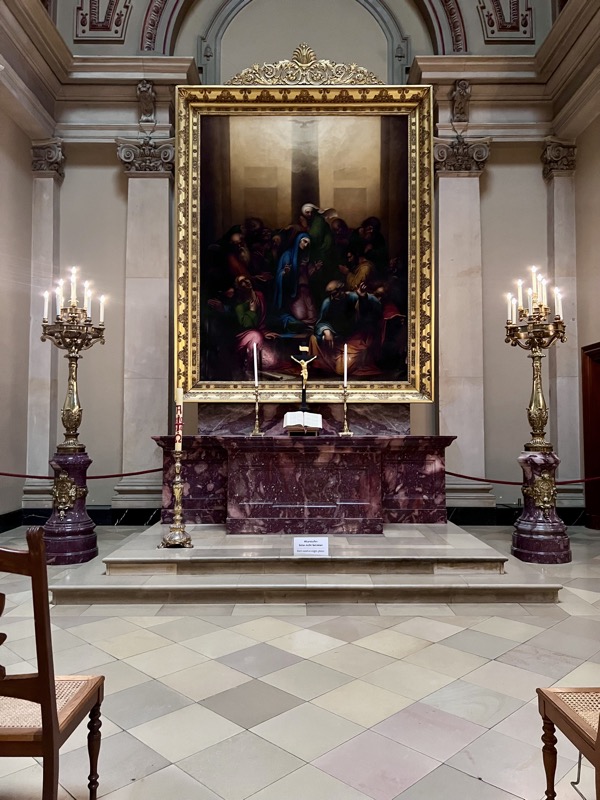
You have to admire the workmanship and dedication that has gone into rebuilding Europe to be the way it was before WWII. They could have bulldozed the lot and replaced these glorious buildings with steel and glass monstrosities – but thankfully there is an appreciation for art and history that overrules that mentality.
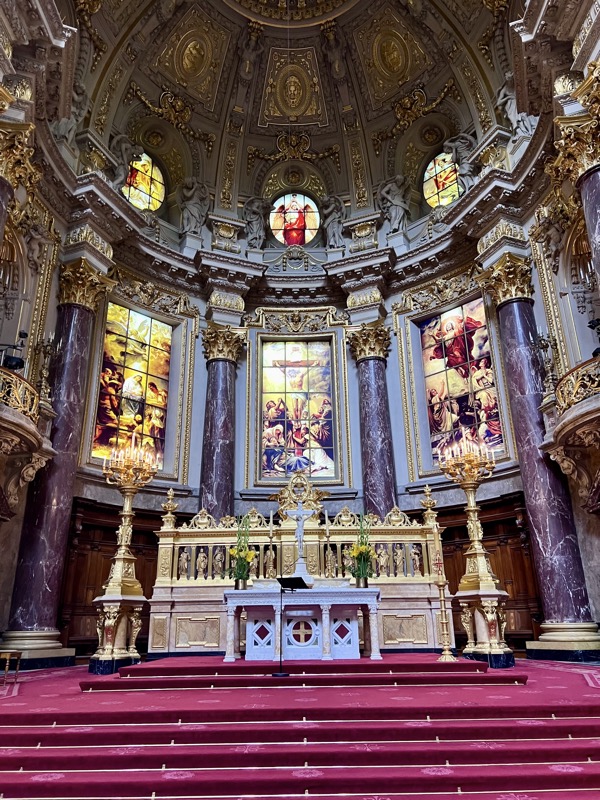
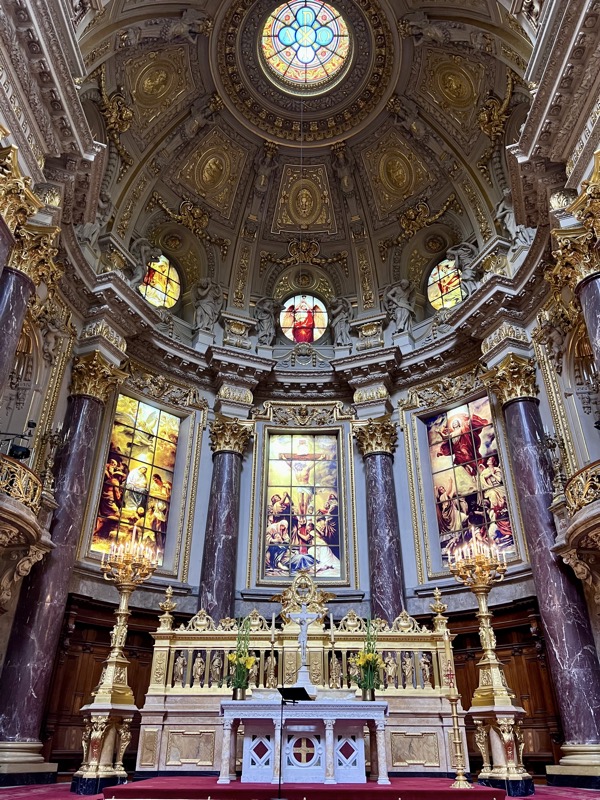
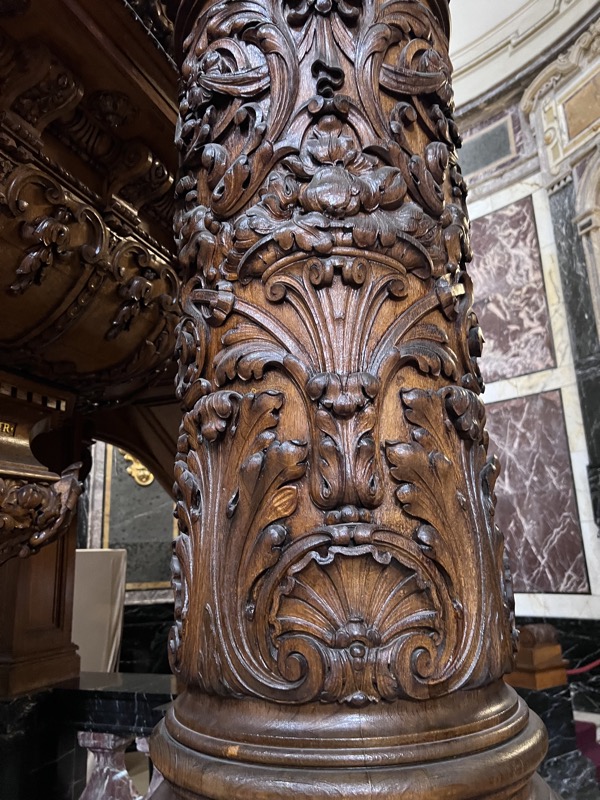
Check Point Charlie was our next port of call, but not before we stopped for some lunch. I had intended to introduce Angus to the Berlin Currywurst Museum – but it’s permanently closed now. C’est la vie! We found a near little tapas bar, which was the nearest place out of the rain… longing for Rabelot in Barcelona!
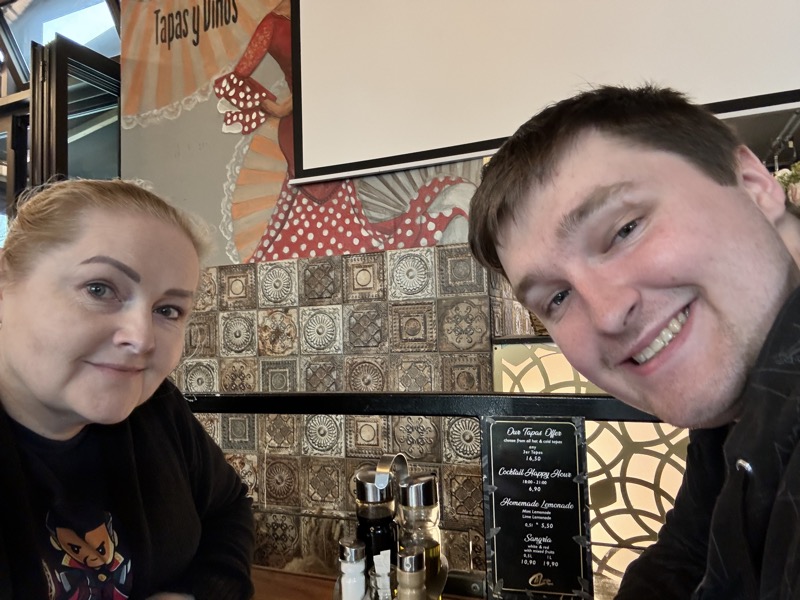
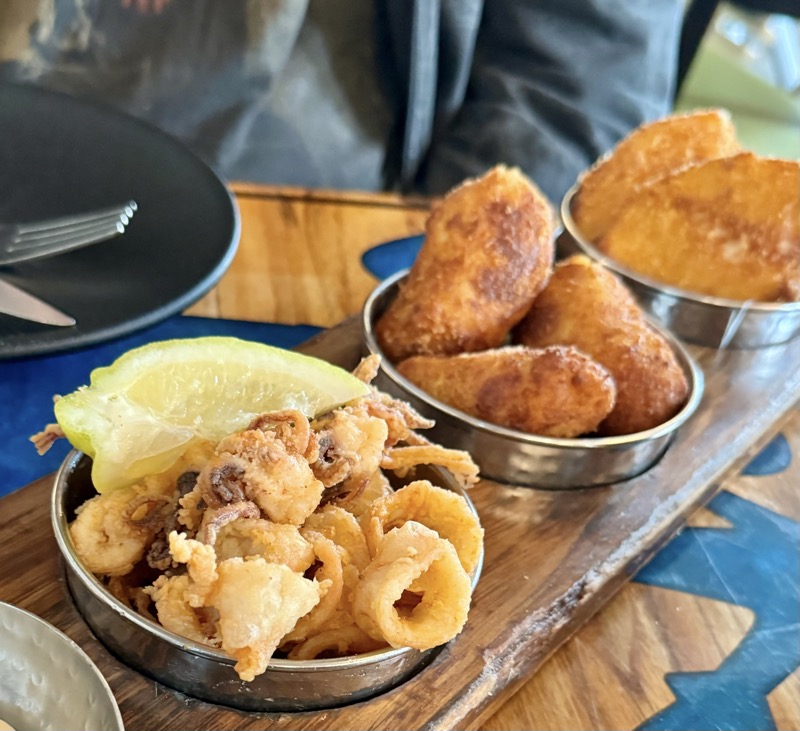
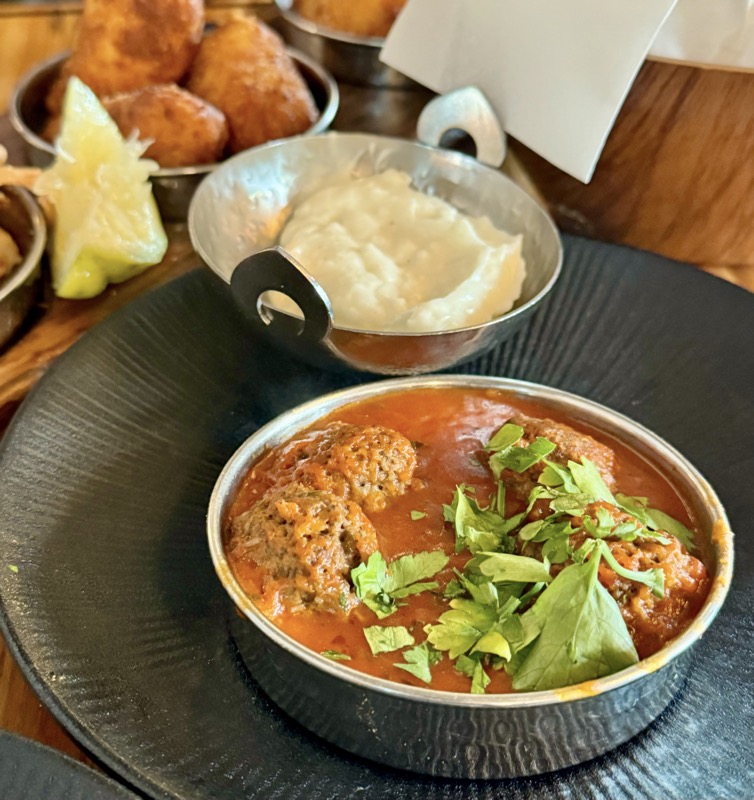
Check Point Charlie (for all its importance in the Cold War and to the US etc) really is the most underwhelming of Berlin sights. Complete with McDonalds and about twenty souvenirs shops, there is nothing else here but a long line of smiling and oblivious tourists waiting to have their photo taken. I’m obviously too young to remember the tense situation that existed on this site post-WWII, but I remember reading about the failed attempt of one East Berliner attempting to flee to the West. He got badly wounded – he got caught up in razor wire fencing and struggled to free himself and ended up being left to bleed to death, all the while being watched by the world’s media with neither side approaching to save him, because it might trigger an enormous international incident. Horrific things like this happened here – but let’s line up for our smiling happy snap photos with our fingers in a V for peace sign.
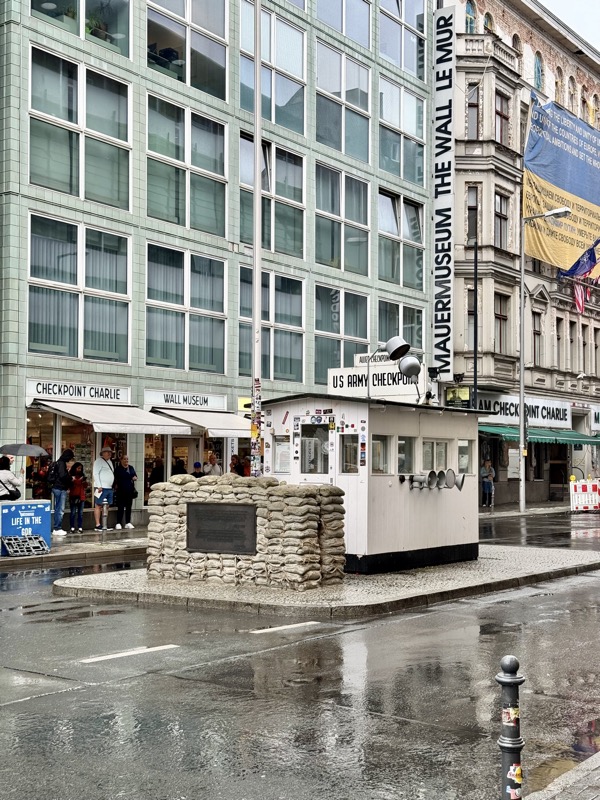
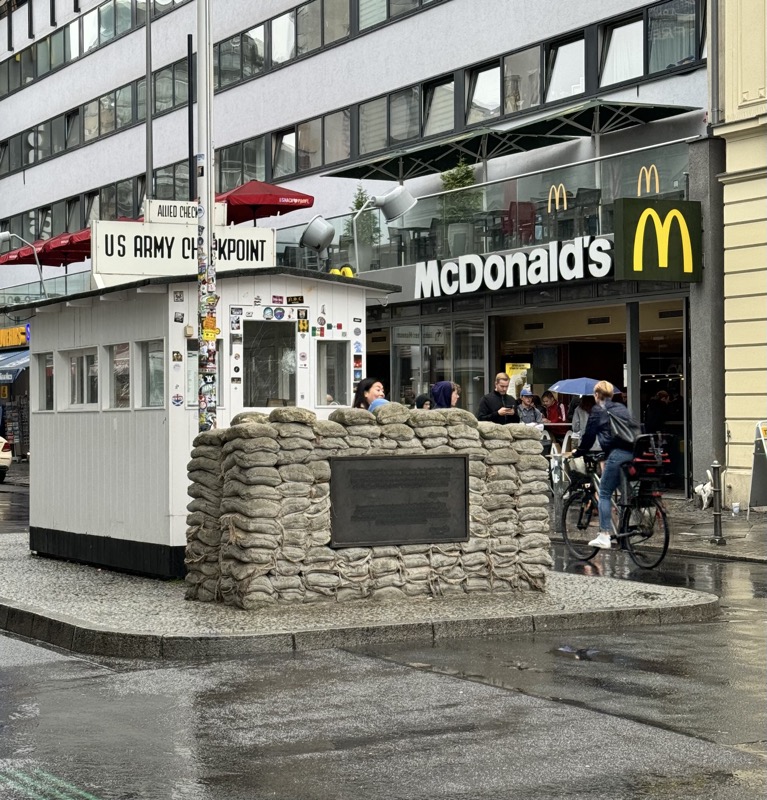
After wandering around there for a bit we went looking for the Jewish Musuem. This building is a research academy which holds archives, a library and is dedicated to tracking displaced persons and Jewish history.
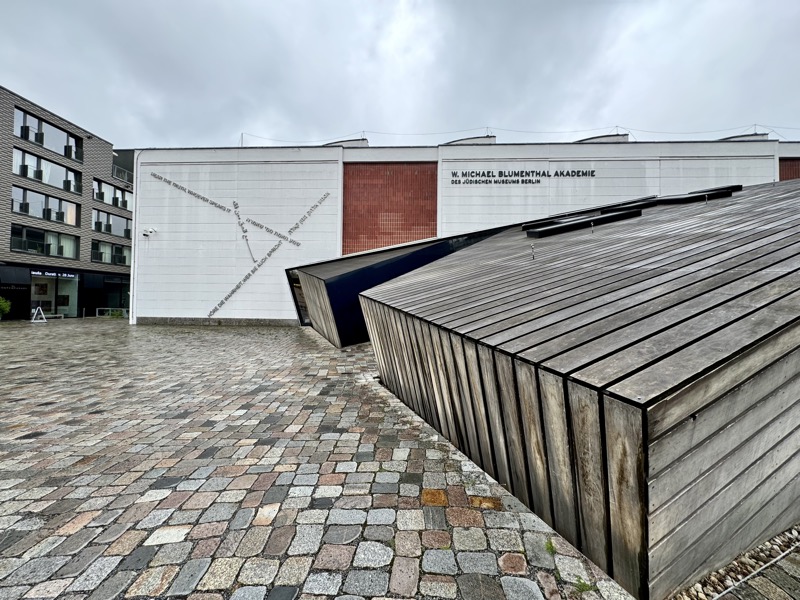
The Jewish Musuem and directly to the right, the Holocaust Tower.
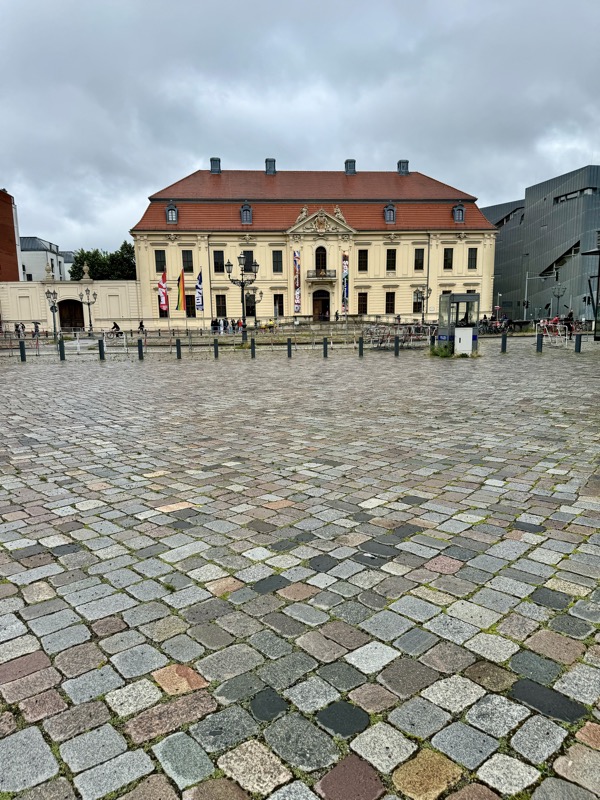
Designed by Daniel Liebeskind, the tower is deliberately filled with voids and uncomfortable angles designed to focus visitors on the impersonal genocide of over six millions Jewish people across Europe in WWII. The building is very effective as an art space – it is cold and impersonal, full of sharp angles and a jagged layout. It deliberately doesn’t ‘flow’, and is designed to feel confronting.
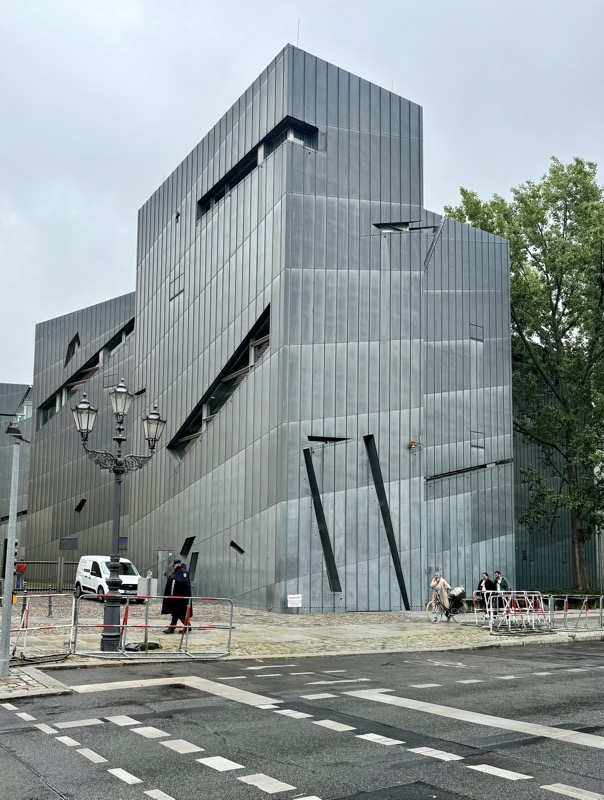
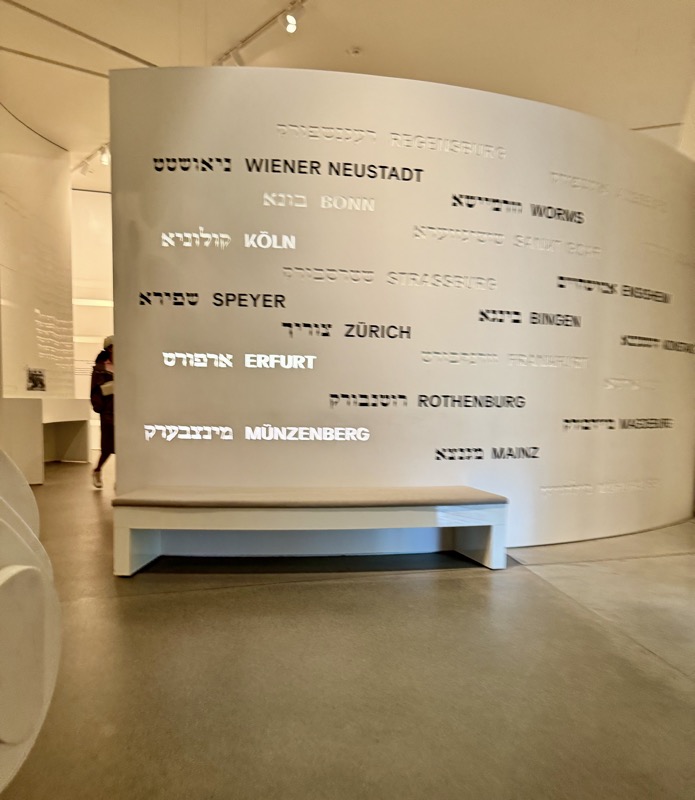
A wishing tree… many of the exhibits here are artistic in nature and designed to be interactive. This tree is bedecked with leave bearing the wishes for peace and prosperity of visitors from all over the world. The museum opened in 2017 and despite the pandemic has already seen 11 million visitors.
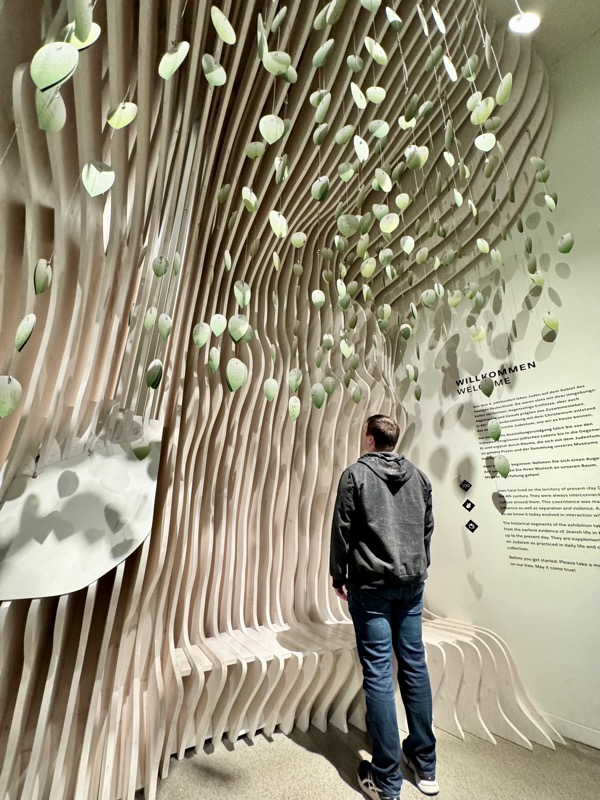
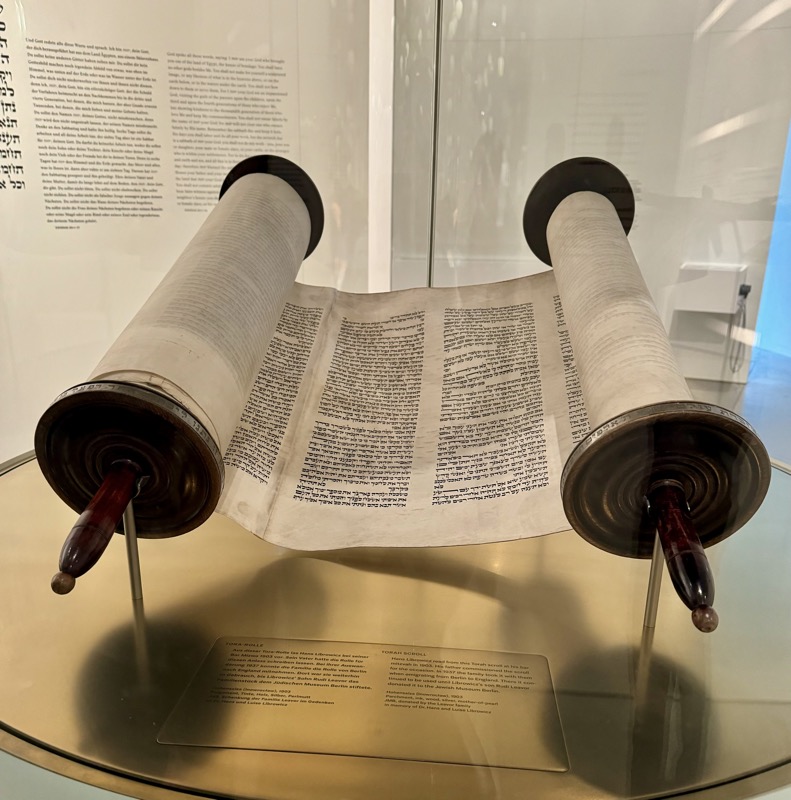
This room memorialises the important of the Sabbath – but I didn’t really get it. It was a room filled with coloure chain curtains hanging from the ceillingwith information plaques stating how important it is to not work on the Sabbath.
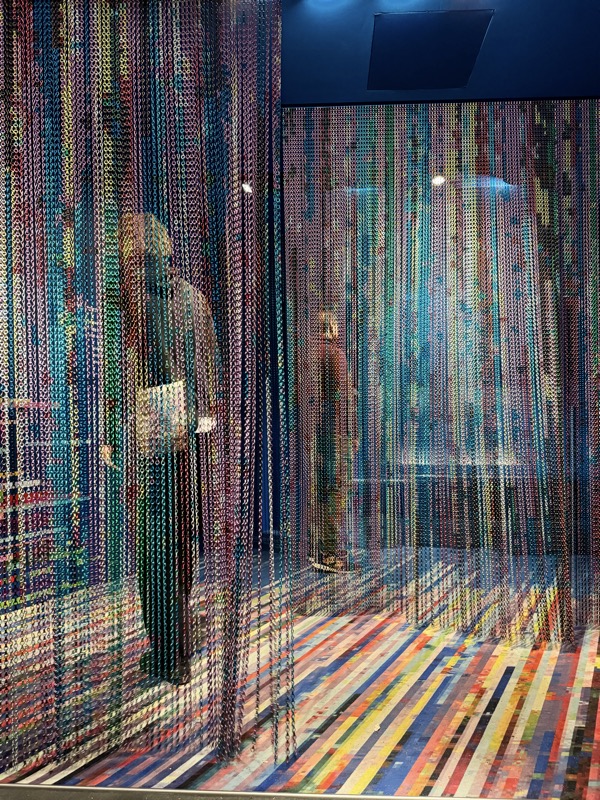
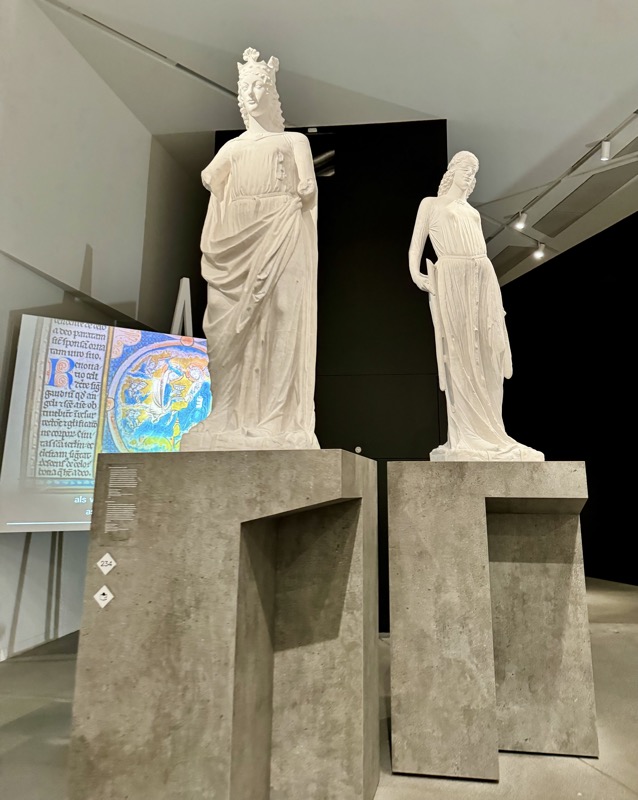
Listening spaces are scattered throughout this curved hallway of chained curtains. There are people offering thoughts and prayers in different languages for the murdered Jews of Europe.
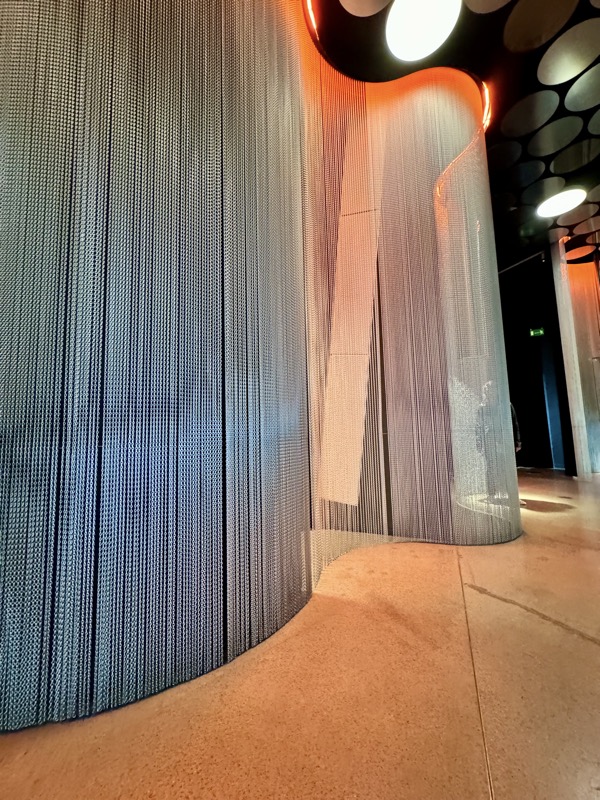
A couple of formal galleries of paintings of eminent Jewish persons were also included in the permanent exhibition.
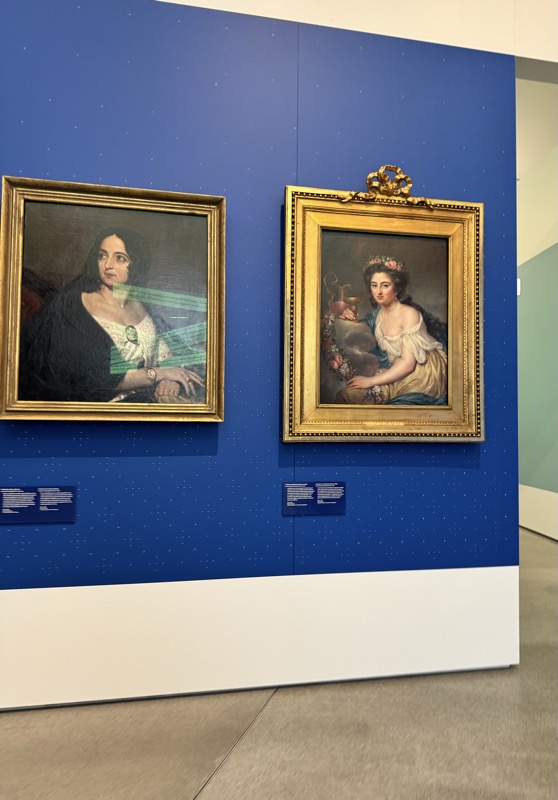
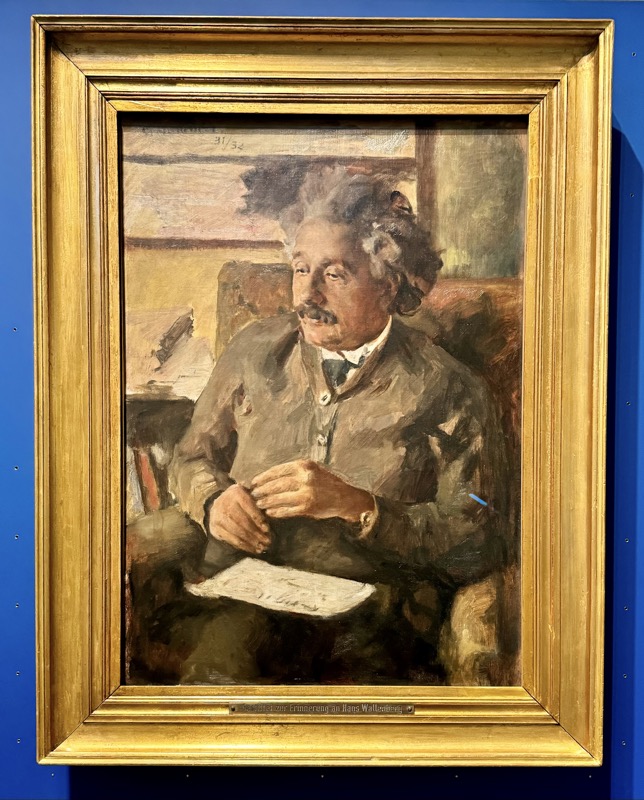
Grave markers and stones, c.1930s. Of the 100,000 Jewish soldiers who fought for Germany in WWI, 12,000 of them lost their lives. That’s right, Jewish people fought for Germany, only for Germany to turn on them a few years later. During the Napoleonic Wars and WWI, rabbis served in the military as chaplains, and wider Jewish community took this as a symbolic gesture of the wider social acceptance of their religious practices.
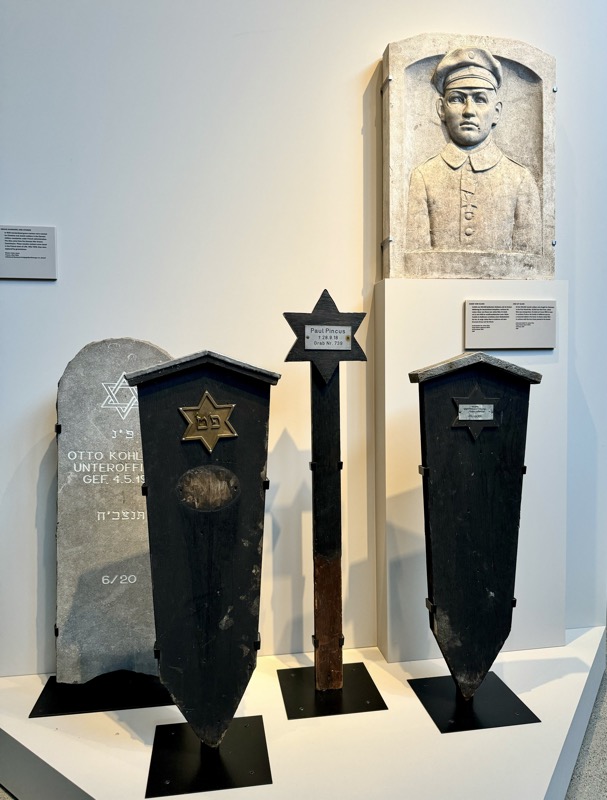
The Hall of Fame: this space is designed to celebrate famous Jewish people who have contributed to history, arts, sciences etc.
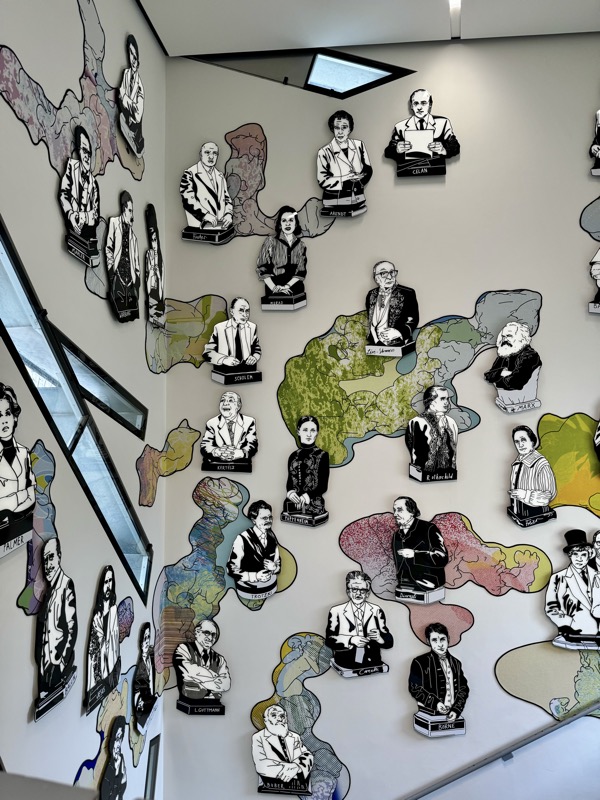
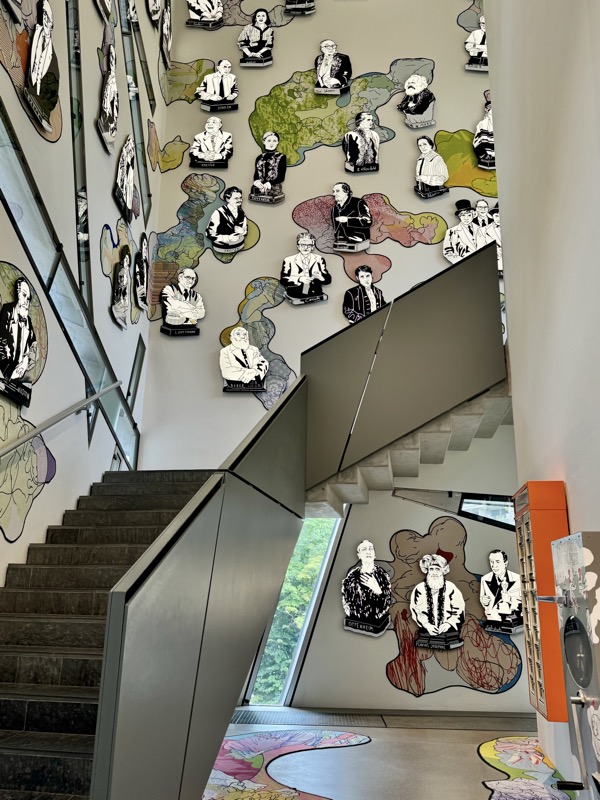
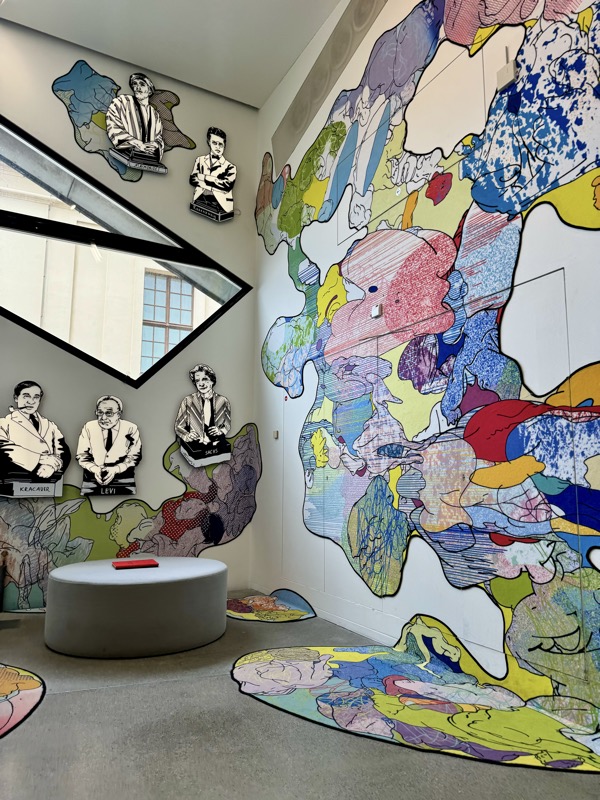
From when Adolf Hitler was appointed Reich Chancellor in 1933, Jews were deprived of their civil rights. Daily harassment, anti-Jewish measures and increasing violence pushed them to the margins of society. State authorities robbed Jews of their assets and drove them to emigrate. Many Jews hoped that things would change and waited ot see what would happen. However, the violence excesses of Kristallnact (the Night of Broken Glass), in November 1938, convinced many it was time to flee. With the start of the war, emigration then brace me almost impossible, and Nazi rule culiminated in the mass murder of European Jews. This installation documents the slow and inexorable removal of civil rights for Jewish people… day by day, orders were created that slowly eroded their citizenship and personhood status.

This was one of the most depressing spaces in the museum, the wall hanging lined both sides of an enormous hallway listing every single edict enacted to suppress and oppress the Jewish people. It stated from 1933 and went thought until early 1945, listing day after day the restrictions being placed on Jewish people across the Third Reich in varying countries as they became occupied territories. The frog in a boiling pot is all I can think about in this room… that and how American conservatives are currently enacting legislation across their country that is restricting the rights and freedoms of their citizenry, even as I walk though this oppressive place.

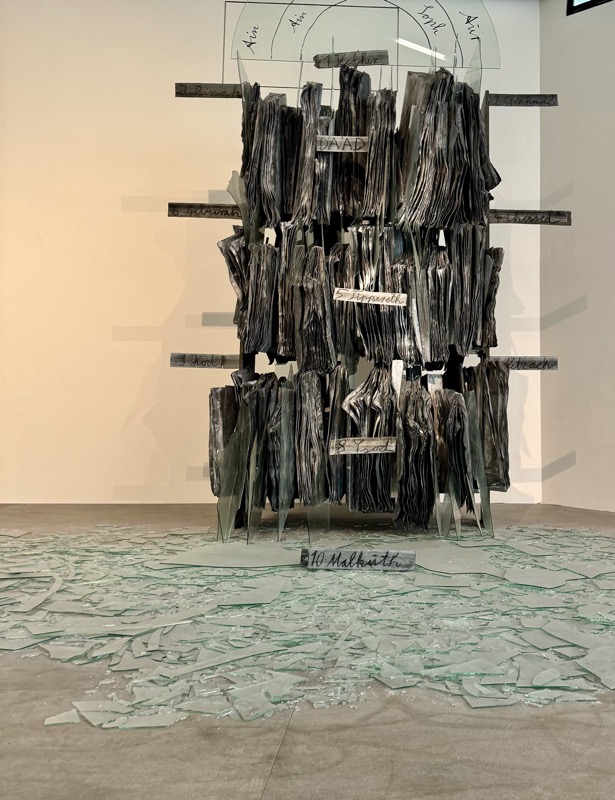
Silverware and family heirlooms taken by Nazis from Jewish families.
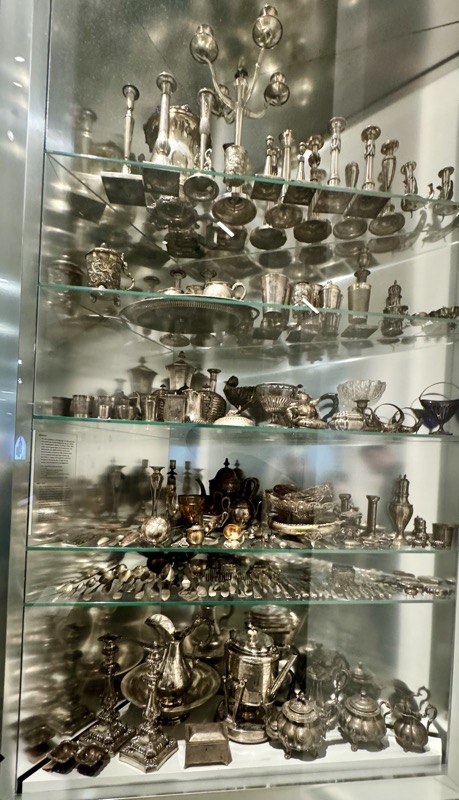
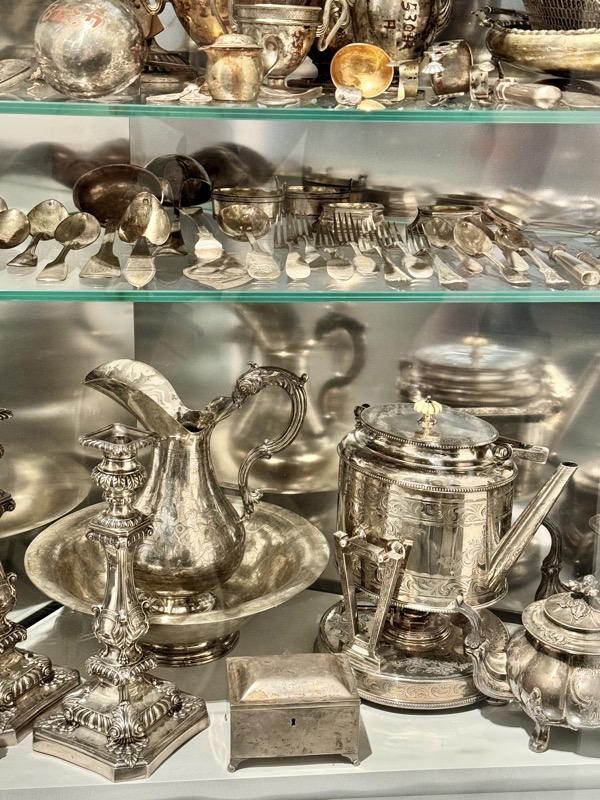
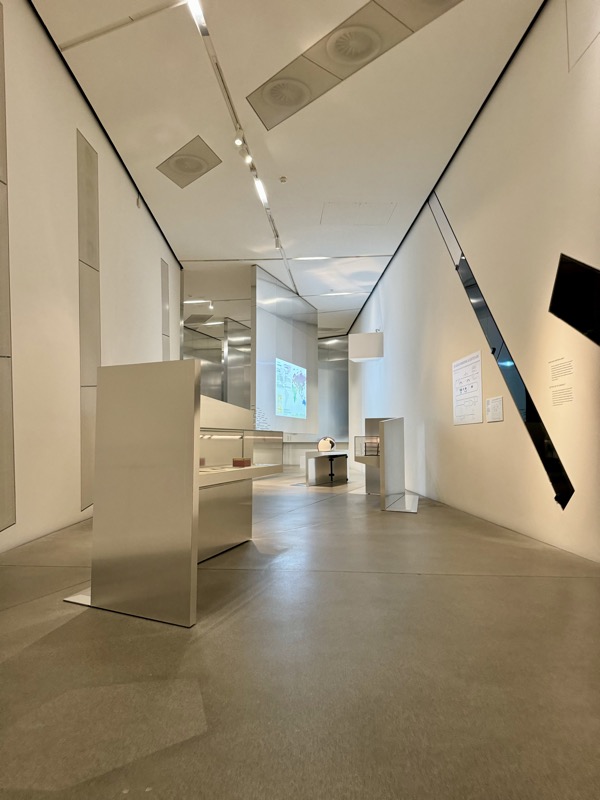
Jewish stars… printed en masse. :’(
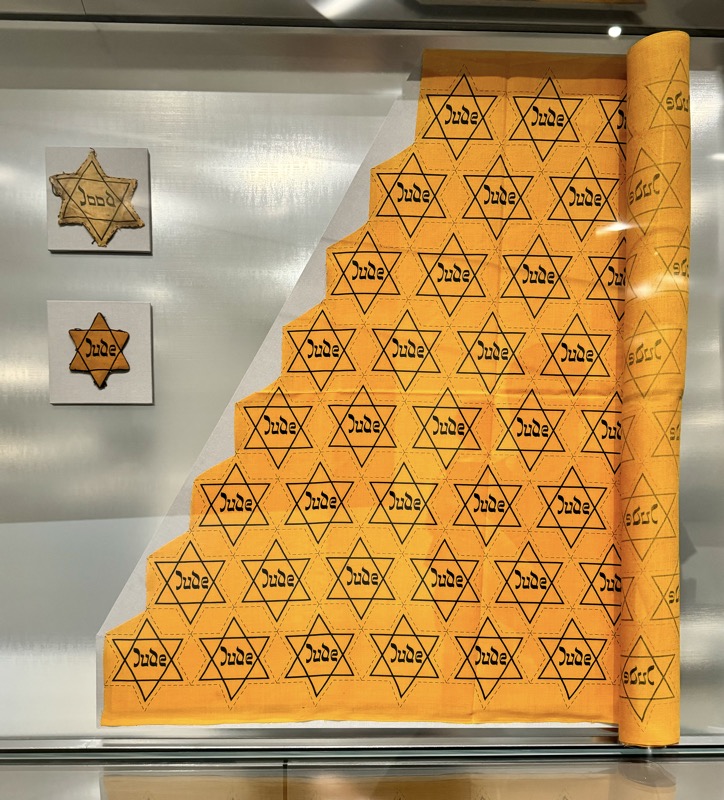
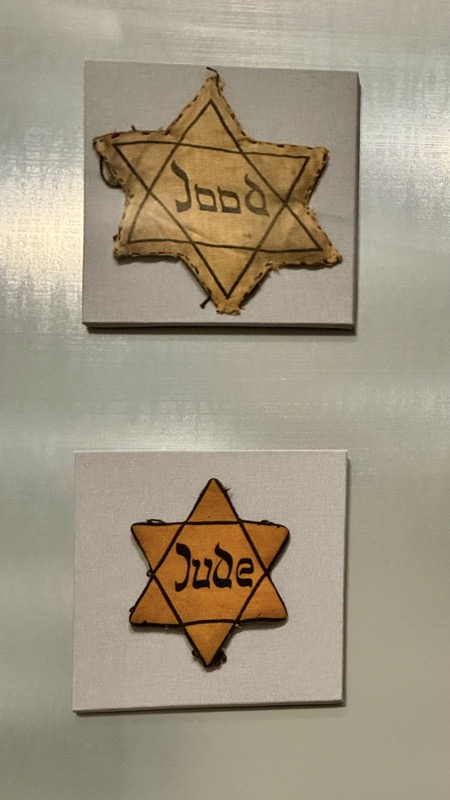
Map showing the deportation of Jews out of Germany.
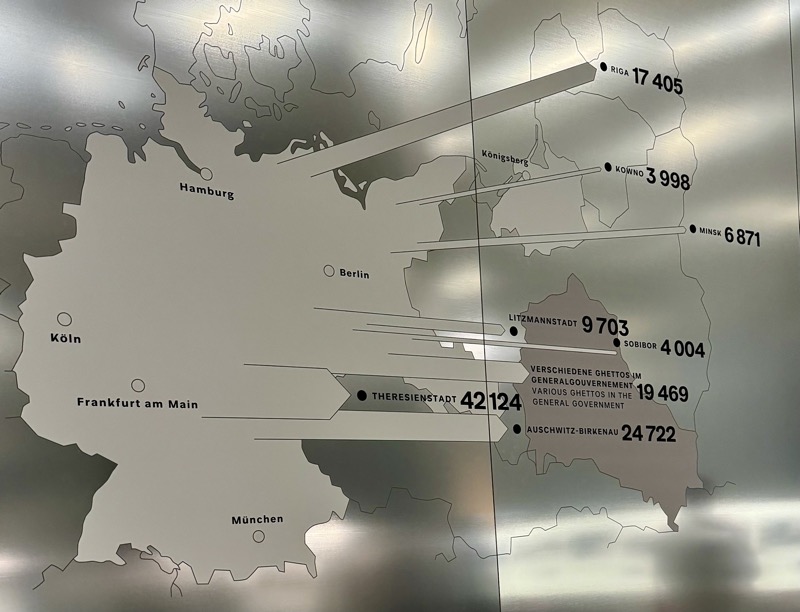
A wall of displaced persons after liberation.
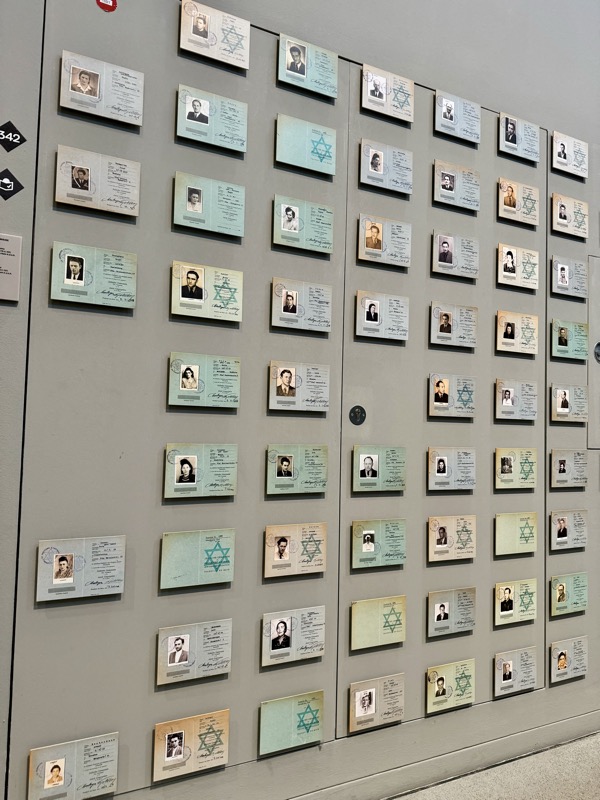
This art installation is about the recompense that the German government was ordered to give the survivors of the Holocaust. Many Jewish people who wanted to get on with their lives, but had had all their assets stolen and had lost all connections with family, ended up stuck in a grindingly slow burn ratio nightmare waiting for compensation. Many wished for nothing more than to get out of Germany and emigrate to Israel, but with the means, they were many of them forced to stay amongst neighbours who had turned a blind eye, or were still openly hostile; sometimes for as many as two decades before their compensation claims were verified (in no small part due to the Nazi regime attempting to destroy as much paper evidence of their crimes as possible as the end became apparent).
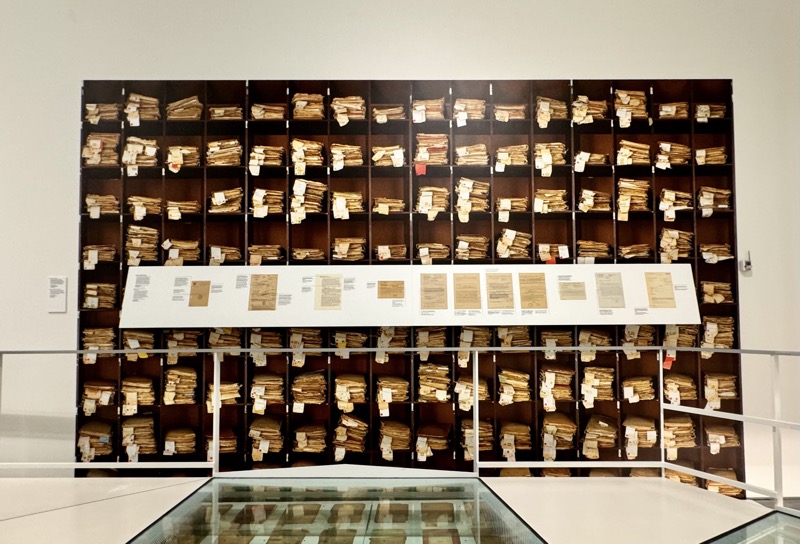
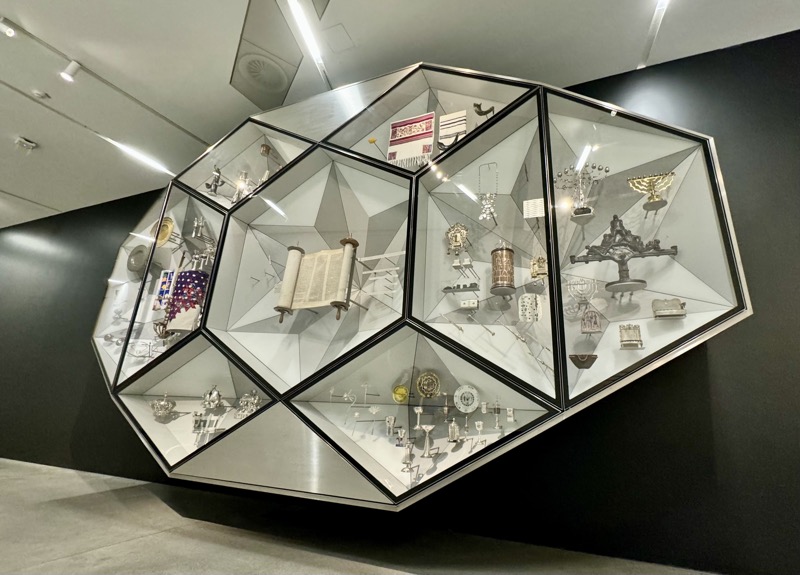
The most famous art installation here is the ‘Shalekhet’ – the Fallen Leaves, by Israeli artist, Menashe Kadishman . It is made from 10,000 faces punched out of steel plate and scattered around the ground of an area called the Memory Void. It is the only empty voided space in the Libeskind Building that you can enter. The work is dedicated to Jews killed during the Shoah, but also to all victims of war and violence. Visitors are invited to walk on the faces and listen to the sounds create by the metal faces as they clang and clank together which echoes through the void. It’s a very evocative installation.
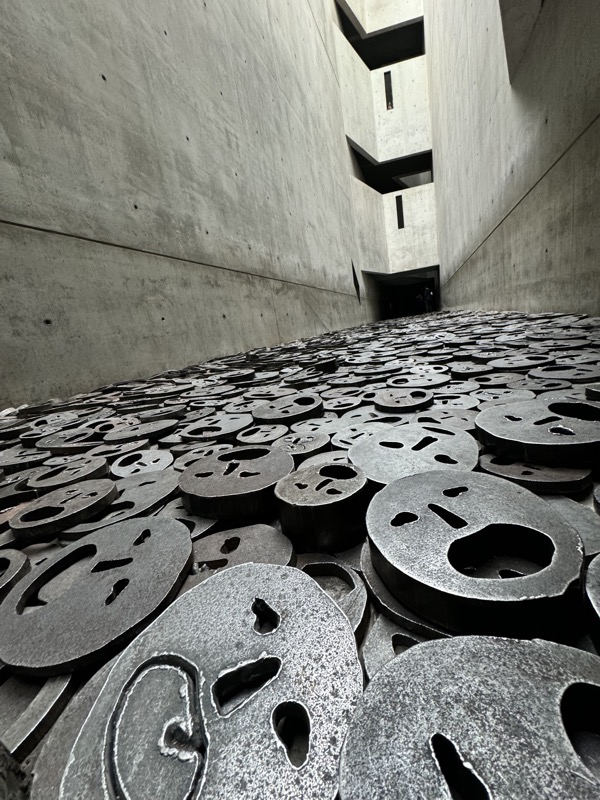
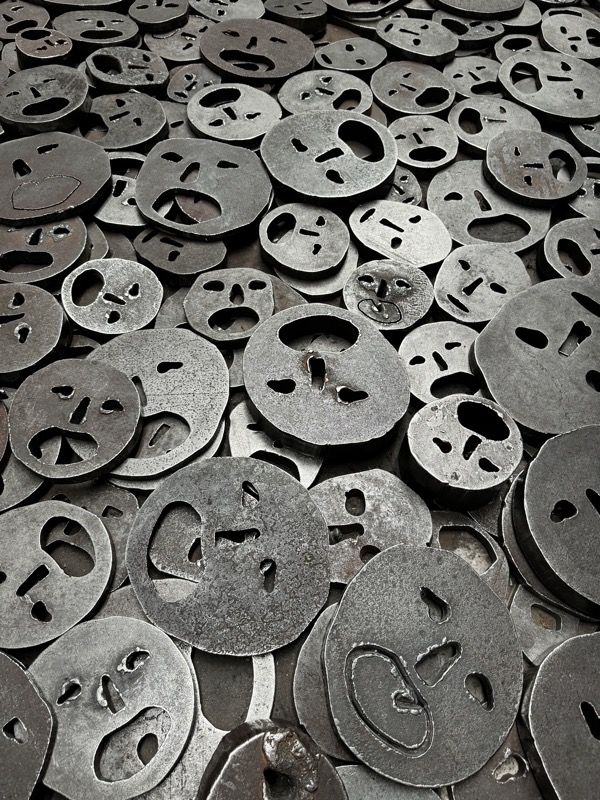
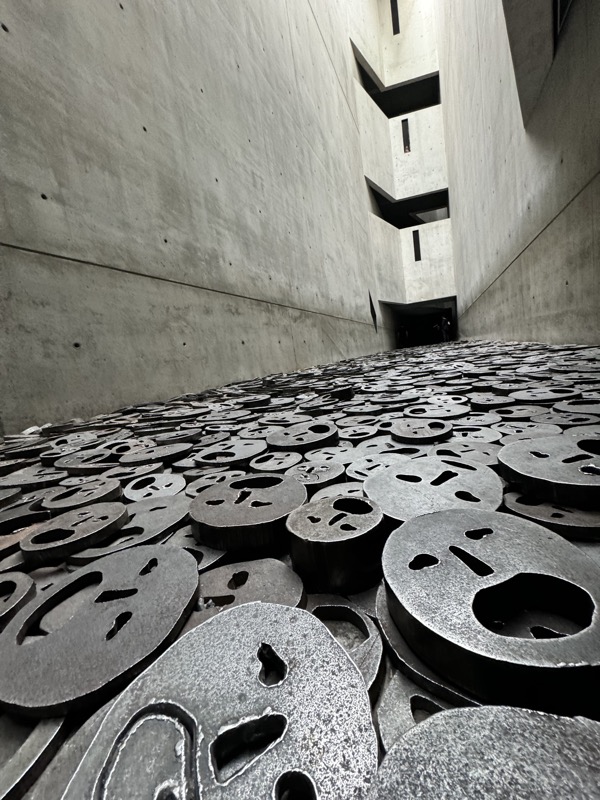
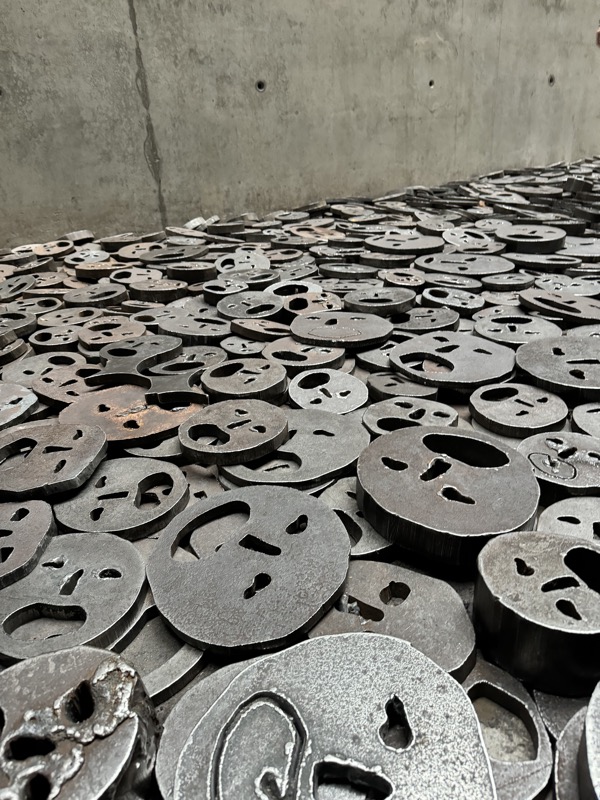
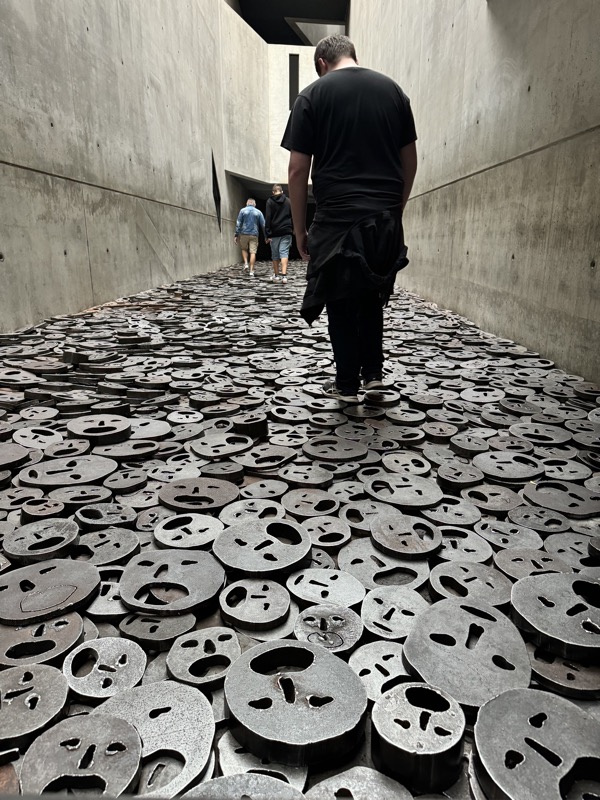
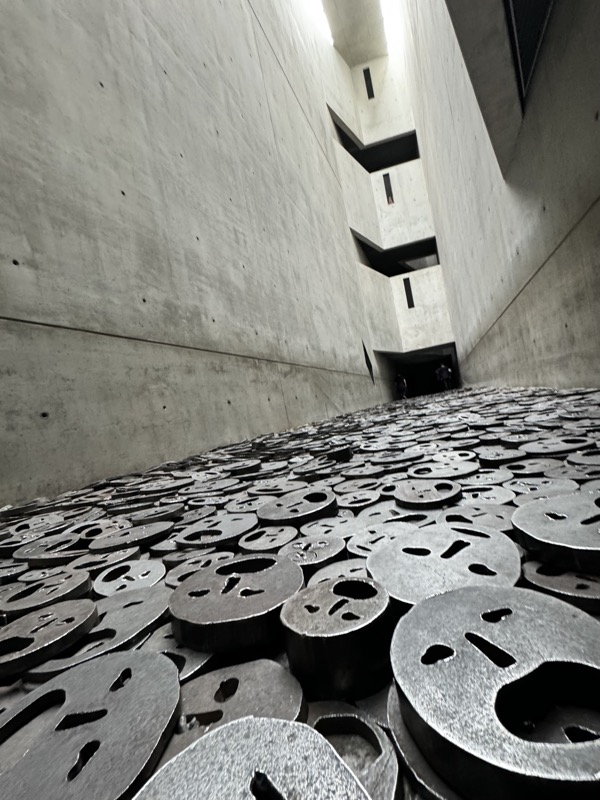
After this we went to the the Memorial to the Murdered Jews of Europe. I have been here before and found it very moving. Built on the former premises of the Gestapo, these stellae are grave like in their dimensions. It covers 19,000sqm and the stellae range from 1m to 4.5m in height as the ground below them undulates up and down. It’s a solemn and quiet space, though you can hear the sounds of the city in the distance.
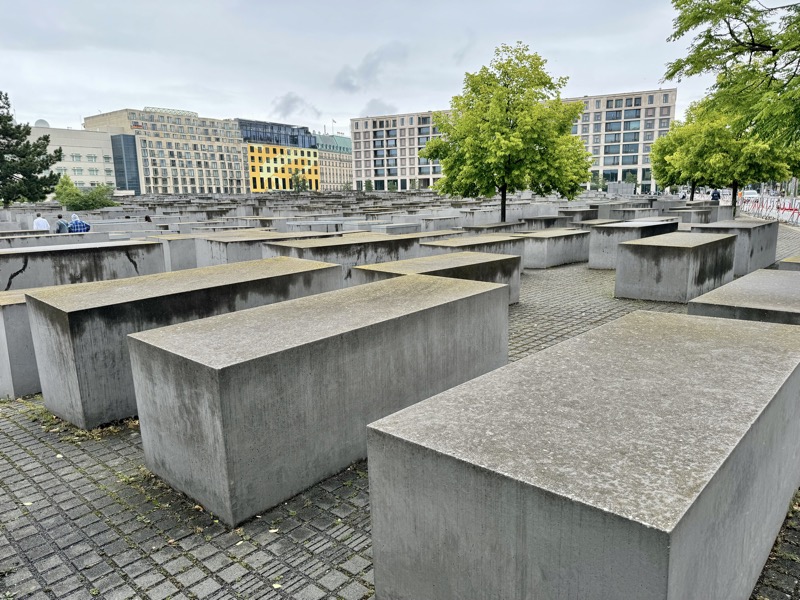
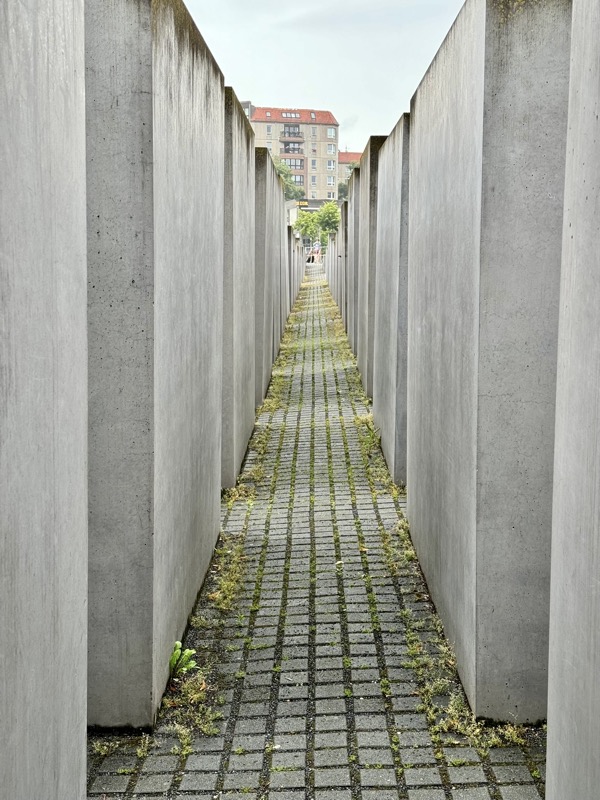
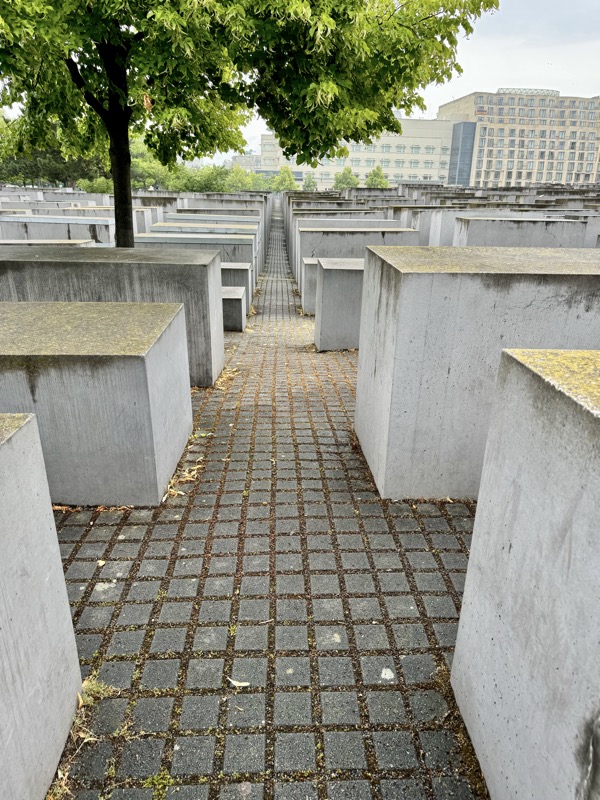
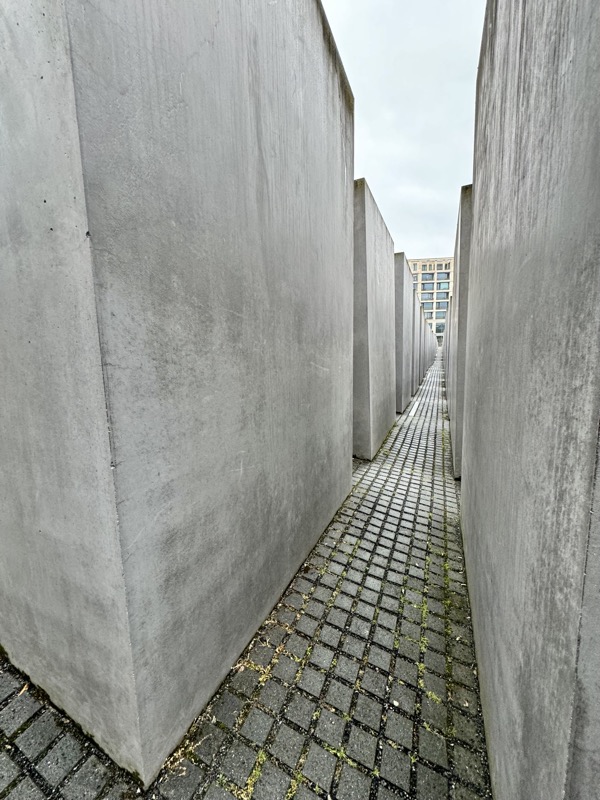
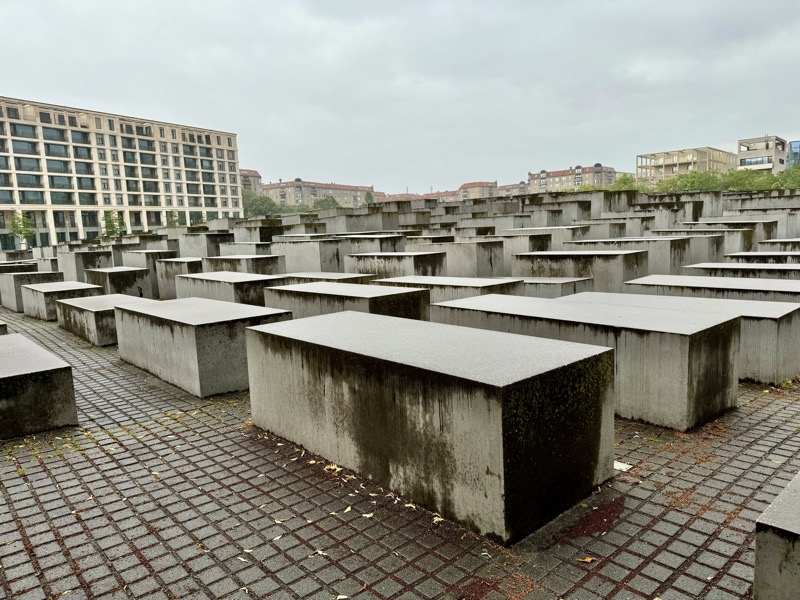
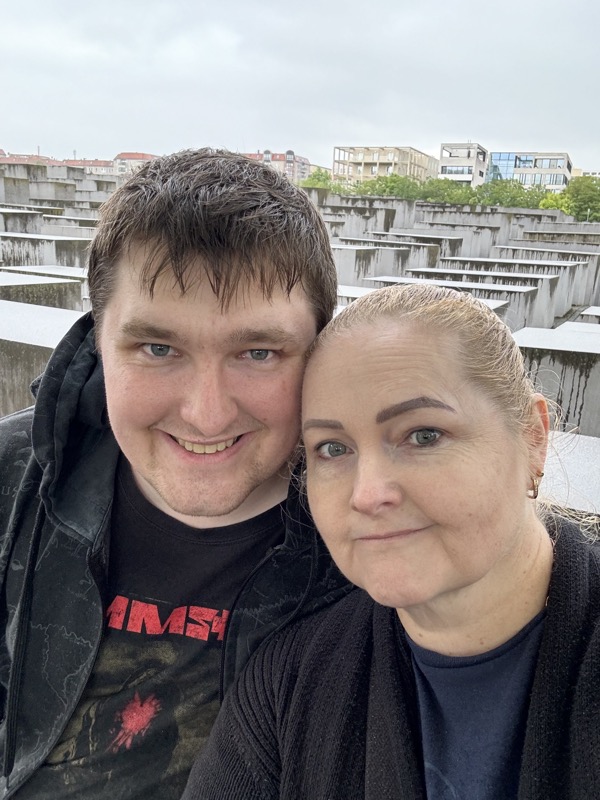
Around the corner is the Brandenburger Tor. With the EuroCup road closures all over the place (useful to see how they have deployed the security and infrastructure etc), we were unable to get close to the Gate.
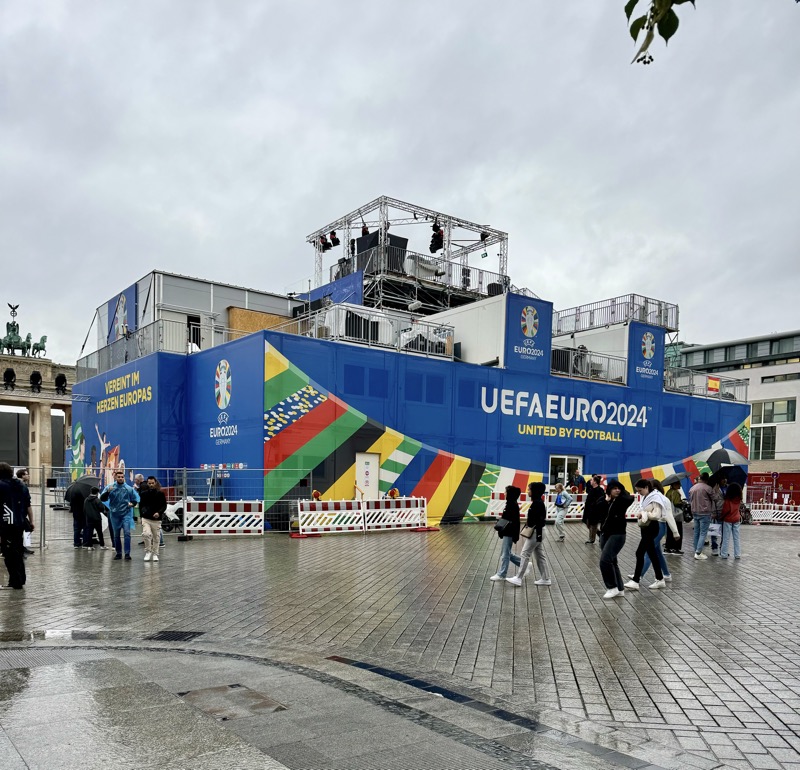
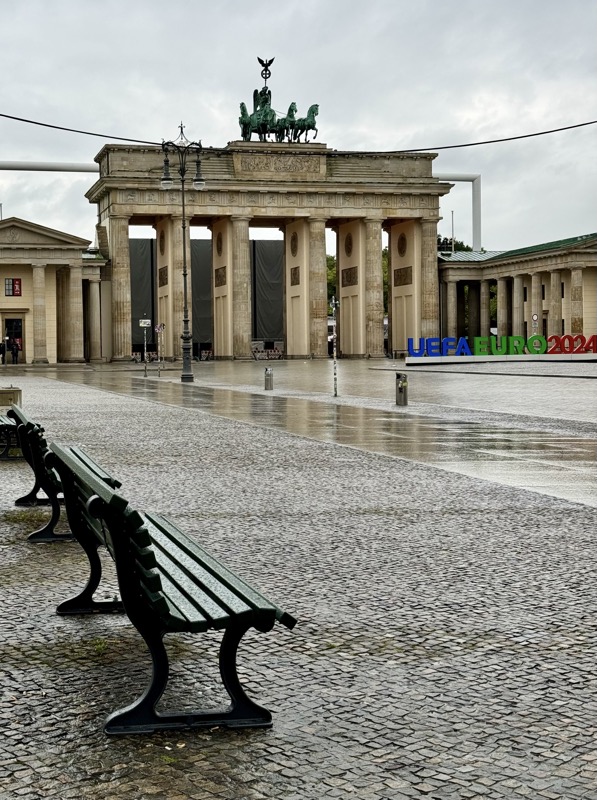
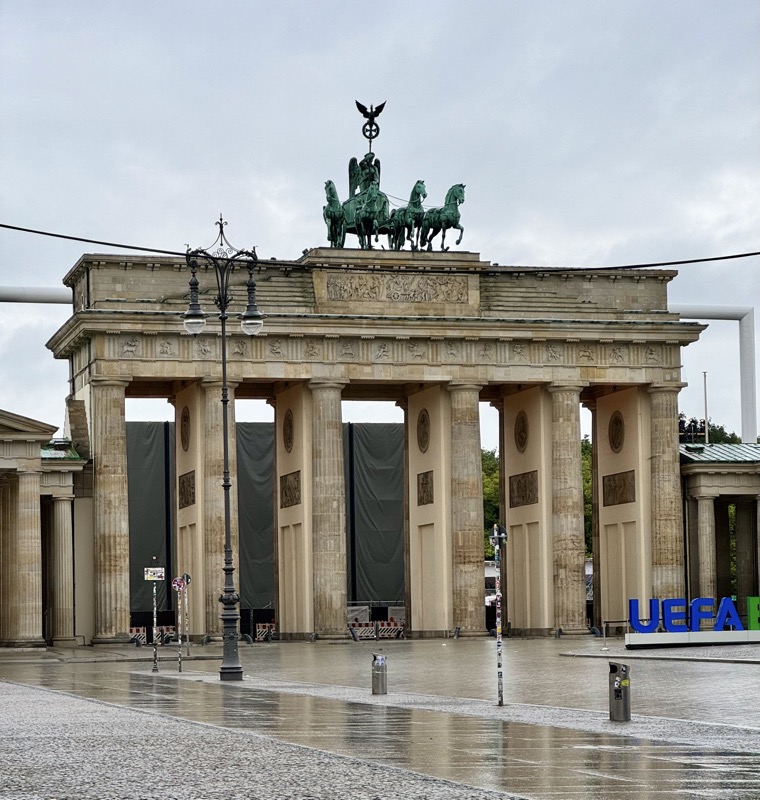
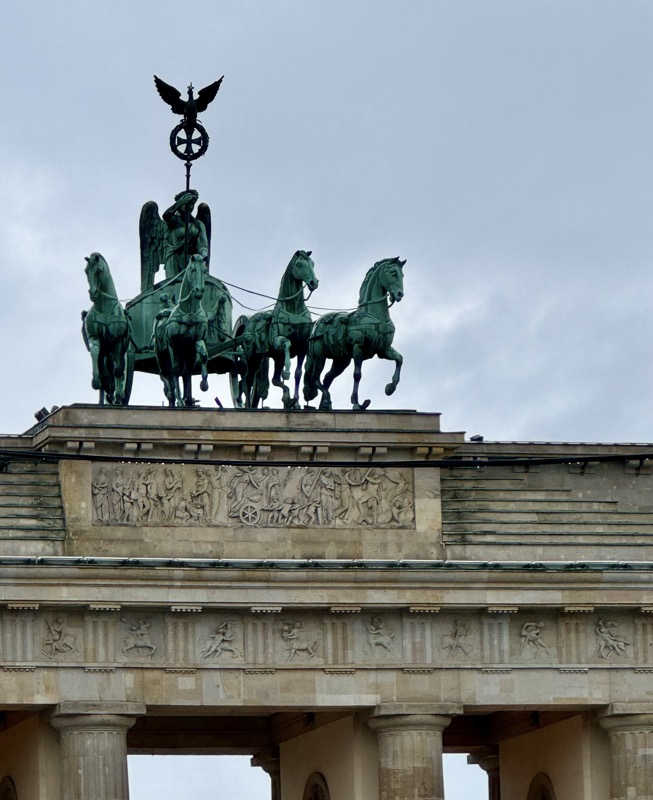
Enough walking around in the rain, we sought shelter in a local bakery only to find that it was closing, so then resorted to as Starbucks (Urgh!) only to back out when we realised we didn’t want to spend money at a Starbucks! 😛 So instead decided to call it a day and return to the hotel to get some more work done.
